












enough” and “best of the best.” And training the best leads to a more time, faster, and as frequently as required. The result: more time in the sky. FSI. Nothing short of excellence. Call +1.201.584.8262 today or visit FlightSafety.com

Dassault Aviation delivered 32 Falcons last year, falling short of its forecast of 35 but two aircraft more than it handed over to customers in 2021, according to its preliminary financial report issued January 4. The French aircraft manufacturer also shipped 14 Rafale fighters, one more than its guidance of 13 for the year but down from 25 in 2021.
Meanwhile, Dassault logged 64 net Falcon orders, inclusive of Russian cancellations due to Ukraine war-related sanctions, up from 51 in the previous year.
This brought Dassault’s year-end business jet backlog to 87 units, a 58.2 percent increase from the 55 Falcons on the books as of Dec. 31, 2021.
On the defense side, the company booked 92 net orders for Rafales, almost doubling the 2021 intake of 49 units. Backlog for Rafale fighters is now at 164 aircraft, compared with 86 at the end of 2021.
Dassault Aviation will release its full 2022 financial results, as well as 2023 delivery guidance for Falcons and Rafales, on March 9. z
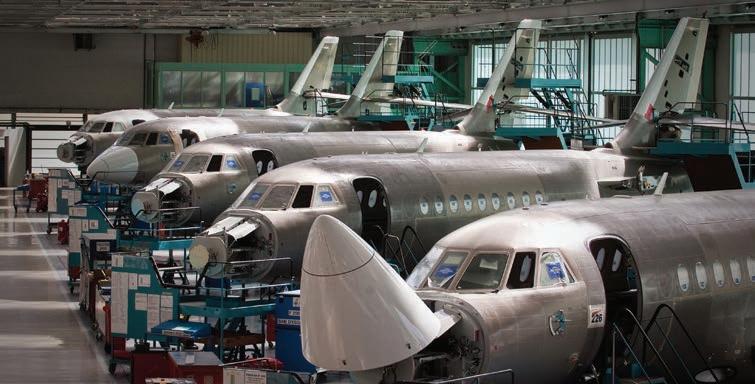
Innovative Solutions & Support (IS&S) has added Beechcraft King Airs equipped with Garmin G1000 and G1000 NXi avionics to its ThrustSense autothrottle supplemental type certificate (STC) program. The move adds a significant number of aircraft to the potential market for the ThrustSense
autothrottle and adds the safety benefits of ThrustSense—including LifeGuard engineout VMCa mitigation—to G1000-equipped Kin g Airs.
The STC covers G1000-equipped King Air 200 and 300 series, of which there are about 800 converted thus far.
Gulfstream on December 16 became the first business jet manufacturer to fly one of its aircraft on 100 percent sustainable aviation fuel (SAF). The milestone demonstration flight from the airframer’s Savannah headquarters using an unmodified G650 was conducted in conjunction with Rolls-Royce, which supplies the ultra-long-range twinjet’s BR725 engines. During the approximately 2.5-hour flight, those engines consumed SAF consisting of a blend of fuels supplied by World Fuel in Paramount, California, and Virent in Wisconsin. SAF is currently approved at blends of up to 50 percent with conventional jet-A, but OEMs are aiming to obtain permission for aircraft to be able to use 100 percent SAF.
Fractional aircraft provider Volato took delivery of its first two HondaJet Elite IIs in late December. These deliveries stem from a recent order the Atlanta-based company placed with Honda Aircraft for 25 of the type, which would increase its fleet of HondaJets to more than 40. The Elite II order preceded one Volato made in September for four super-midsize Gulfstream G280s, which will be added to the company’s fractional fleet.
Textron Aviation is now equipping production Beechcraft King Air 360 turboprop twins with an electrically driven air conditioning system. “The new system for the King Air 360 represents our continued investment in an already iconic product,” said Textron Aviation senior v-p of sales and flight operations Lannie O’Bannion. Built into the structure of the aircraft, the system doesn’t a ect cabin space. The system can operate without the engines running by plugging into a ground power unit, which reduces the environmental impact of engine emissions.
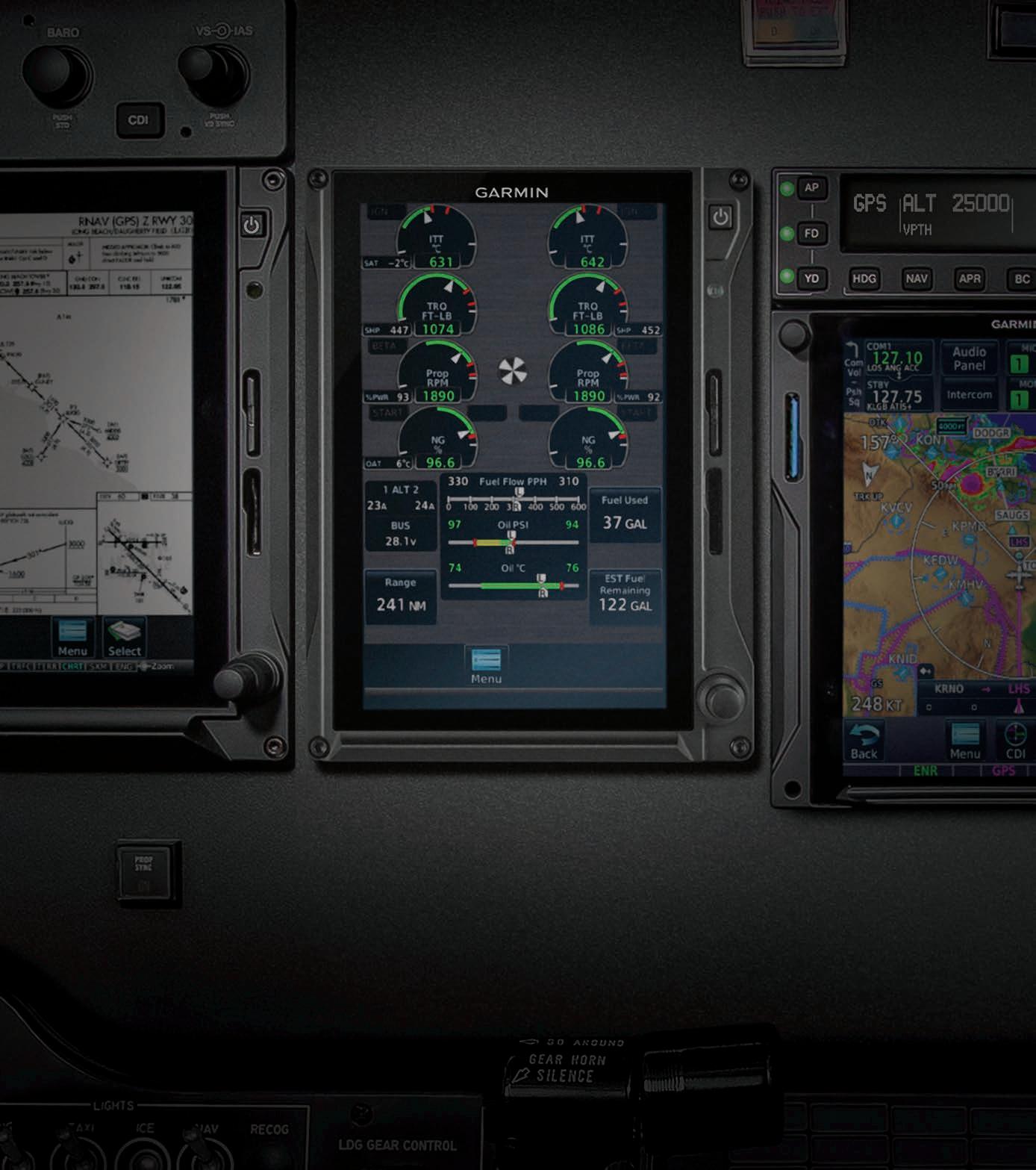









Following the surge in private flying from newcomers with the onset of the Covid pandemic, demand looks to be diminishing from that group, according to industry analyst and consultant Brian Foley.
Supporting his thesis are data from WingX and Amstat that show slowing activity in branded charter and an increase in preowned aircraft inventory. Those metrics “indicate the peak has passed for the general public’s discovery and fascination with private aviation,” Foley wrote, adding that many of them are returning to the airlines. Furthering that dampening of demand are concerns over a recession and the expiration of 100 percent bonus depreciation in the U.S.
At its peak, Foley noted, charter operators were reporting as much as 50 percent

of their business coming from people who had never chartered before. OEMs such as Textron Aviation reported 20 percent of their customers were new to aircraft ownership. The decline in private flying demand could affect orders that fractional and charter companies placed for new aircraft to address the pandemic-induced clamor.
Foley estimated that less than 10 percent of those new to private aviation will remain. However, he said, “It still favorably raises the baseline obtainable market for the industry from this point forward. This is frankly a relief for an industry that was never scaled to be a mass-transit system and has been overwhelmed over the last couple of years.” z
Private equity firm New State Aviation Holdings on January 3 announced the purchase of Blackhawk Aerospace in a deal that complements its December 2021 acquisition of TBM dealer Avex. Waco, Texas-headquartered Blackhawk develops engine upgrades for turboprop airplanes. New State Aviation CEO Chad Cundi said Blackhawk will complement Daher TBM sales, brokerage, and maintenance provider Avex and allow the company to o er “a broader suite of services and meet more needs of light turbine aircraft owners.”
The FAA’s analysis of 5G cellphone network C-band transmitter e ects on aircraft radio altimeters has shown that the impact on aviation operations is in specific areas. At the same time, the agency has determined how the C-band signals a ect aircraft radio altimeters and how these avionics units can be upgraded to tolerate the interference. In light of this new information, the FAA is proposing to revise AD 2021-23-12 to reflect new operational requirements. The revised AD will add “interference tolerance requirements for radio altimeters that can be used across the a ected fleet.” Non-radio altimeter-tolerant aircraft will continue to face operational restrictions and retrofits would have to be done by Feb. 1, 2024.
The Campaign for Better Transport (CfBT) is calling on the UK government to impose a tenfold increase in the air passenger duty for private charter flights. The environmental group also wants business aviation to lose its current exemption from the country’s 20 percent value-added tax (VAT) and for this levy to be imposed on every aircraft movement, regardless of flight duration.

Teterboro Airport in New Jersey regained its status as the busiest business aviation airport in 2022, according to data from WingX Advance.
Despite the post-Covid bounce in business aircraft flight activity waning over the latter half of 2022—with December down 2 percent from a year ago—WingX Advance said it was still a record year. The more than 5.5 million business aircraft flights recorded globally by WingX last year was 10 percent higher year-over-year, 53 percent above 2020 levels, and 14.4 percent above 2019.
At 2.8 million flights, North America accounted for about half of this traffic last year. Business aviation flying in this region was up 11 percent from 2021, 65 percent above 2020, and 18 percent above three years ago.
Most of the growth in this region came from private and corporate flight departments, which represented some 40 percent of all business jet activity, WingX said. Reflecting this surge, Teterboro Airport in New Jersey regained its status as the busiest business aviation airport in 2022.

Europe recorded 600,000 business jet flights last year, up 10 percent from 2021, 56 percent above 2020, and 15 percent higher than in 2019. France was the top
business aircraft market in Europe in 2022, followed by the UK and Germany.
Outside of North America and Europe, business aircraft activity last year climbed 20 percent above 2021, 74 percent from 2020, and 54 percent above 2019. Private flight departments were responsible for 41 percent of all departures in the rest of the world in 2022, marking a 29 percent increase from 2021. Notably, Qatar saw 400 percent year-over-year growth in traffic last month, driven by the hosting of the FIFA Men’s World Cup.
“December 2022 activity was down yearon-year but was still the second- busiest December on record and capped off a record year for global business aviation flights,” said WingX managing director Richard Koe. “The trajectory month-tomonth has been downwards for the last six months in Europe, where demand may fall back to 2019 levels this year. The erosion from peak demand in the U.S. has been more modest, and the market should sustain higher than pre-pandemic activity during 2023.” z
The FAA on January 11 issued a proposal to update and expand safety management systems (SMS) requirements to encompass aircraft manufacturers and Part 135 charter, commuter, and air-tour operators. U.S. airlines have been required since 2018 to have an SMS, and the expansion of SMS to other operators and aircraft manufacturers is intended to address a congressional mandate and recommendations from the NTSB and two rulemaking committees. Additionally, the proposed rule would more closely align the U.S. with ICAO Annex 19. The proposal would require those a ected to have an SMS in place one to two years after the rule takes e ect.
Airbus Helicopters finalized its acquisition of ZF Luftfahrttechnik, an MRO provider and manufacturer of helicopter components in Germany. It is now operating as a wholly owned subsidiary under the name Airbus Helicopters Technik. ZF Luftfahrttechnik has delivered more than 10,000 gearboxes and is a supplier of the Airbus H135 main gearbox. The company is also a major MRO for the German armed forces. It had revenues of €94 million ($98.9 million) in 2021.
Fixed and capped hourly rate jet cards and memberships increased 4.9 percent over the final three months of 2022, according to private aviation services buyer’s guide Private Jet Card Comparisons. The average hourly price climbed to $11,748 across all categories in the fourth quarter, capping a 21 percent rise for all of last year. However, the company said, minimum charges decreased to 94.7 minutes in the fourth quarter. The result was the cost of shorter flights dropped by 8.8 percent in the quarter.

 US: Albany, Alexandria, Austin, Bozeman, Burbank, Dallas, El Paso, Florida Keys, Gulfport-Biloxi, Honolulu, Houston, Indianapolis, Jacksonville-Cecil, Lake Charles, Lake Powell, Medford, Moses Lake, Orlando, Richmond, Riverside, Rome, San Antonio, St. Louis, Stennis, Syracuse, Tallahassee, Topeka, Tucson, Victorville, White Plains, Yuma Canada: Toronto, Vancouver, Calgary Colombia: Cartagena
US: Albany, Alexandria, Austin, Bozeman, Burbank, Dallas, El Paso, Florida Keys, Gulfport-Biloxi, Honolulu, Houston, Indianapolis, Jacksonville-Cecil, Lake Charles, Lake Powell, Medford, Moses Lake, Orlando, Richmond, Riverside, Rome, San Antonio, St. Louis, Stennis, Syracuse, Tallahassee, Topeka, Tucson, Victorville, White Plains, Yuma Canada: Toronto, Vancouver, Calgary Colombia: Cartagena
While crisis response management provider Fireside Partners has been an exhibitor and presenter at NBAA’s Schedulers and Dispatchers Conference (SDC) for years, for the show’s latest edition in Nashville in late January, the company featured its Air-SOS program for the first time.
Launched in late 2021, the program focuses on specialty airlift assistance such as aeromedical transport, the repatriation of remains, or other sensitive flights where extra care and discretion are required. The company has established a thoroughlyvetted authorized provider network and organizes all transport details including the sourcing of aircraft.
“Through this network, we have access to several specialty-configured aircraft to meet the different requirements of the unique operations we work, including larger medevac aircraft, which provide patient/passenger comfort closer to what our clients experience on their
own fleet,” said Sarah Kiehl, Air-SOS program manager.
Arrangements also include setting up ground handling, coordinating with hospitals or funeral homes, and obtaining required approvals from local officials. The company can also provide counseling, family assistance, and personal effects handling services.
So far, Air-SOS has received an average of one request for assistance per week, a rate that it expects will increase as it becomes more well known, and has fielded missions as short as from Casper, Wyoming to Dallas to as far as Rochester, Minnesota, to Jakarta, Indonesia.
“What we’ve found in our first year of providing these services is that many families don’t know how di ffi cult making airlift arrangements is until something tragic happens and they are scrambling to find support on short order,” explained Kiehl. “We [were] excited to have the opportunity to spread awareness of our services at SDC2023, so we can help more families in their time of need.” z
FlightServ, which began operations at New Jersey’s Trenton Mercer Airport in 2017 as one of two FBOs, has opened its permanent facility there. The $30 million, 22-acre complex features a two-story 30,000-sq-ft terminal with passenger and pilot lounges, showers, tenant o ces, snooze rooms, a catering kitchen, two 12-seat conference rooms, concierge, and cafeteria. It represents a major upgrade from the company’s previous 1950s-era terminal that was returned to the airport authority for use by the New Jersey State Police. An adjoining 80,000-sq-ft heated hangar adds much-needed hangar space.

The Meridian FBO at California’s Hayward Executive Airport joined the Avfuel Network. As a branded dealer, the location will participate in Avtrip, Avfuel’s loyalty program, and o er Avfuel contract fuel. Its 6,300sq-ft terminal and o ce building feature a passenger lobby and lounge, business center, conference room, pilot lounge, snooze room, shower and locker facilities, and kitchen. Along with 3.5 acres of ramp space, the IS-BAH Stage 2-registered location also has a 30,000-sq-ft hangar and plans to add an additional 30,000-sq-ft hangar.
Air Culinaire has completed the move of its major facility in London to a 8,700-sq-ft kitchen just minutes from Luton Airport. The improved facility—more than four times the size of the former location—features modern cooking appliances, energye cient equipment and lighting, antibacterial flooring and walls, and retractable spray-down systems for cleaning. It also includes pass-through refrigeration portals to maintain temperature compliance.
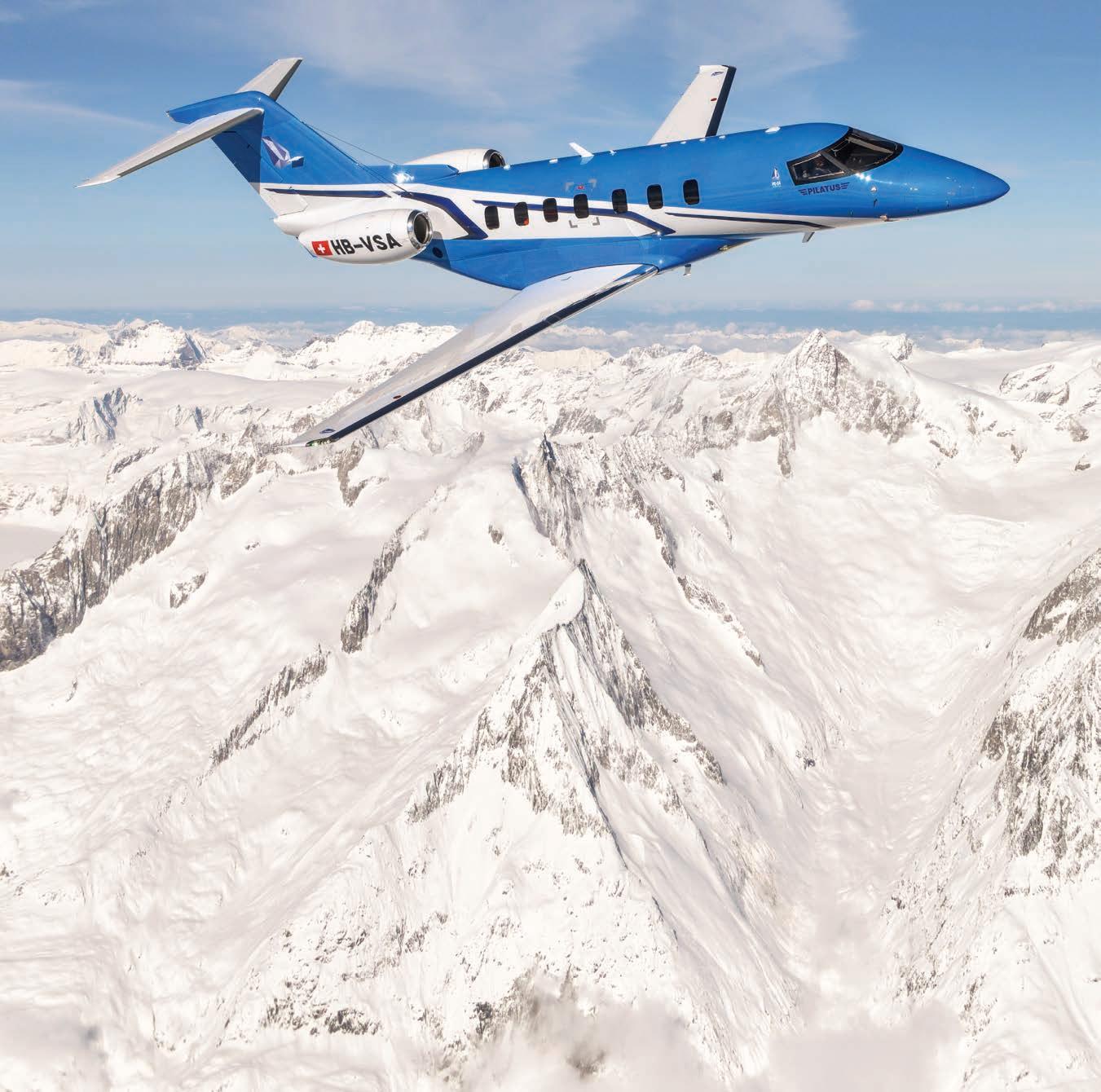
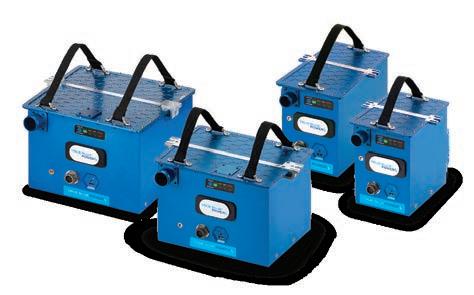
 BY MATT THURBER
BY MATT THURBER
Craig Erickson took over as safety program manager for Solairus Aviation more than six years ago after his predecessor was promoted to assistant chief pilot (later chief pilot). Erickson studied safety management systems in college and after learning to fly, worked in the air-medical industry in dispatcher roles, eventually joining TriState CareFlight in Utah as dispatch supervisor. After taking on the safety program manager role at Solairus, Erickson stepped up the company’s and employees’ participation in safety programs. He shared his experiences with AIN.
You’re responsible for safety programs for the whole operation?
That incorporates our entire safety management system [SMS], which goes through our safety audits, safety risk management through our reporting systems, and our safety policies.
SMS is foundational, but the FAA still doesn’t require SMS for Part 135 or Part 91 operators.
Solairus has had an SMS since basically day one. It definitely has taken some time to further develop it and enhance it and make it more usable.
Every person that comes to Solairus, it doesn’t matter your position, you’re going to receive SMS training and also emergency response training. It’s one of those core foundational pillars of our organization that continues to develop. If we ever just think that we have arrived, that we are safe, we’re fooling ourselves. There’s always something we can do to continually improve the safety of our operation.
Was the SMS developed in-house or did you work with an outside vendor?
We go through external audits and we take those best practices that are continually evolving and incorporate that into our organization. By having those audits
and evaluations, it helps us to say, “Maybe we’re missing something, or we’re deficient here, or we need to explore something to help us to make sure that we are always looking for [improvement].”
SMS is an active hands-on program, not a book that sits on a shelf.
It is a living, breathing thing in our organization. It doesn’t matter if it’s one of our frontline pilots, a maintenance supervisor, even our office staff or charter sales folks, or accounting, everybody is involved with our safety management system. Everybody receives recurrent SMS training, of course on different levels according to their specific job function. But it’s a great opportunity to let people know we are actively trying to make things better for them in their workplace and [their] job.
Can you give an example of how the SMS enhances safety and how Solairus has used it to mitigate the risk?
Every flight goes through a flight release process. During that process, we look at a lot of different factors. Are the pilots qualified to go? Is the airplane legal? Are there operational concerns? And we find these things through our flight risk assessment tool [FRAT] for every single leg. Through that we can identify a records problem,
maybe a medical that’s expired, or a maintenance limitation. And then what other risks are they going to encounter during that flight?
The flight crew has that discussion as part of their pre-flight briefing to say, “We are legal. We’ve identified the risks through our FRAT, and we are good to go. We think we’ve mitigated those. We have our fatigue management system that’s baked into our processes, where if there’s a fatiguing situation, we’ll hit that before the trip and put in mitigating factors.” That’s been a game-changing element for us.
When you onboard a new owner, how do they learn about this safety philosophy?
Our executive team, it’s one of their topics of concern that they bring up and they let them know, “You are going to be watched over just like it’s one of our own family members that’s going to be on that aircraft. You can expect that we will do everything in your best interest to get you to your destination safely.” It’s that oversight that helps them feel assured that they’ve signed on with an organization that values that as a core belief.
So how do you, as the leader of the safety program, monitor everyone’s compliance and participation and
Reimagine your place in the sky 12 hours and 5,650 nautical miles of non-stop performance.
The ACJ TwoTwenty has reimagined executive and private travel. For a similar investment, enjoy twice the space of any other large cabin business jet and lower operating costs.

make sure that you’re communicating this philosophy to everybody at the same time?
Number one, our safety reporting system is a non-punitive reporting system. If people have made a mistake, or lapse, or have had a problem, they’re not going to get blasted by that. We’re going to have a conversation to help understand and do a root cause analysis of what led to that decision or that event. Based on those, we’ll take corrective actions. Was there a procedural problem? A training issue? A behavioral problem? What can we do as an organization to provide resources to our folks, so that doesn’t happen again? Then communicating that back to the rest of our company.
We have what’s called a client aviation manager (CAM) call where we invite all the CAMs to join online. We have a series of discussions, whether it’s a leadership module or maybe a maintenance module. I always have a safety presentation where I can tell people about the risks that we’ve identified, and here’s what we’re doing to mitigate those risks.
I talk to a lot of other safety operators, I start with the Air Charter Safety Foundation [ACSF] data-sharing network. We’re part of that. Every six months there’s the info share conference that we attend where we are gleaning a lot of information about what else is happening in the industry. What’s said there stays there. But we can internalize some of those principles, and the data that’s being shared there is helping us identify opportunities to improve.
All of us are experiencing the overpressurization of the industry, where we’re expected to do more with fewer resources. That’s where we have to share that information and say, “Look, we’re not gonna fly to this location because we see it as a risk.” I share that information with others. “Hey,
are you doing this trip? Are you having this problem?” I was recently at a conference where we had about 20 other safety operators, and all of us were saying, “We have to as an industry come together to stop having these accidents and these events happen.”
There’s a school of thought that instead of firing someone for making a mistake, we should view it as an opportunity to teach and that afterward, that person will never again make that mistake.
We’ve seen a similar thing. By doing that approach it creates ownership. It creates buy-in and a true shared sense of responsibility for that airplane. They don’t treat it like just another job. When I was going to college, I was working at Delta Air Lines on the ramp and I was pushing out L-1011s with 300-plus people on board. I had no idea the risk that I was undertaking, no idea whatsoever, and nobody ever explained it to me. I look at that now, holy cow, what was I thinking? But if we can help people understand the true risk that they’re undertaking by moving these aircraft, by being part of the system, then hopefully it will help to curb some of those unfavorable events that we’ve seen happen.
How do you actively work with nearly 300 aircraft and hundreds of outlying operations?
We have an all-crew call where everybody gets online a couple of times a year. And we have our base audit program, we visit folks. I’m constantly in communication through email and phone calls, at all hours of the day and night. Our safety committee meets regularly. We’ve been trying to make sure people don’t feel like they’re on an island out there all by themselves, and having that constant communication. The CAMs are doing a good job of portraying the information that needs to seep down into the ranks. Then if I need to get involved, say on a specific group like all
the Challenger 604 crew, I can send information to them.
When there is an actual safety situation, who can raise their hand and put a halt to things?
Every person has the ability to stop and say, “We need to reevaluate.” We expect that. They’re being paid to say, “Wait, this doesn’t look good,” or “We need to do a timeout and reevaluate what we’re doing and get a new game plan together.” We encourage them and reward them to say, “This didn’t look good and that’s why we stopped.” And never will they ever be blasted for doing that.
Do the people at Solairus take that seriously? Are they willing to raise their hand?
We’ve seen several times where people said, “Okay, wait, we only have two wing walkers. We need a third one before we’re gonna start towing this airplane or moving the aircraft.”
Or if we’re taxing in and we only see the marshall out there without wing walkers, we’ll hold our position here until you get those people in place. Empowering people to do that, to make those decisions, usually [results in] good circumstances afterward. We have people that are not injured, aircraft that are not damaged, and ownership that develops with people saying, “I can make these decisions and not fear retribution.”
Are you happy with Solairus’s progress in safety?
It’s been fun to see it evolve from when I started. And I’m excited to see where it’s going. We’ve had incredible resources to help us to get where we’re at. We won’t be sleeping on this at all. There won’t be a time when we think we’ve arrived. I’m hopeful that we can keep up with the challenges that are ahead of us, and I think we will, we’ll meet those challenges head-on and come out successful.




Over the last 20 years, the number of whole aircraft transactions sold from major fractional companies has not accounted for many of the overall transactions. The average amount of fractional sales of whole aircraft makes up just 3 percent of the total preowned transactions in the industry. Overall, these fractional sales have not had a major impact throughout the industry on pricing or inventory for the past 20 years.
Fractional companies have done a great job of not flooding the market with inventory while trying to protect the resale values of the aircraft types they are divesting; however, these companies do need to move on from their aging aircraft.
Somewhere past the tenth year of operations, the fractional companies divest of their aging aircraft.
When major fractional companies chose to divest a particular fleet, in most cases, there has been a major impact on pricing and inventory.
For instance, from 2011 through 2014, fractional sales of Beechjet 400As made up an average of 40 percent of all transactions involving that model per year for consecutive years.
The Beechjet 400As had a 28 percent loss in value in the four years fractional sales accounted for 40 percent of the transactions. A typical rule of thumb is that a corporate jet would depreciate 5 percent to 7 percent over its life. As one would expect, this curve is generally steeper in the first several years of an aircraft’s life and by the age of 12, the curve tends to flatten out. In the case of the Beechjet 400A, it depreciated 7 percent per year, the upper end of normal but
Total Sales (Beechjet 400A) vs. Fractional Sales (400A) 2011 - 2014
Beechjet 400A
higher than usual considering the age of the aircraft.
With the Citation Ultra, fractional sales accounted for 66 percent of total transactions over a three-year period from 2008 to 2010. There was a 45 percent drop in value for the Citation Ultras over this three-year span. It is clear the infusion of high-time formerly fractional aircraft had a major effect on the price drop. The price drop for the Citation Ultras during this period averaged 15 percent per year, almost triple the normal decline in pricing for a corporate jet.
There may be some advocates that will argue that despite the price decline, owners of low-time corporate aircraft are not hurt by the market being flooded with low-cost, high-time aircraft. There is no question that low-time, corporate-flown aircraft will sell for much higher prices than former fractional aircraft.
The fact is that in any situation that removes buyers from a market, pricing
drops and time on the market increases, which costs the owners money. These high-time aircraft still have the same cabin and the same performance as the low-time, corporate-flown aircraft, and some buyers will purchase the high-time aircraft instead of the higher-priced low-time aircraft.
In another case, fractional sales of Gulfstream G200s accounted for an average of 37 percent of the total transactions from 2014 through 2016. The resulting decline in values over that same period was 41 percent, which is an average of nearly 14 percent per year. This is more than double and closer to triple the industry average of a 5 percent to 7 percent decline in value per year.
In 2016, fractional sales of Citation X’s accounted for 75 percent of the total transactions and the market value for the Citation X dropped 25 percent in one year.
Throughout their history, the major fractional companies have done their best to
release aircraft in a metered fashion while attempting to keep pricing as normal as can be reasonably expected. As in the case of the Citation X, caveat emptor! Be careful when buying the same aircraft type as major fractional companies because when it comes time for that operator to divest of that fleet of aircraft, for owners of similar aircraft types, values could be adversely affected.
Consider that high-time, relatively low-cost aircraft will be around for many years too, so the effects on pricing will last for years.
Those high-time aircraft have the same cabin and performance as the low-time aircraft and some buyers will take the discounted aircraft. z
Kevin O’Leary is president and CEO of private aviation services company Jet Advisors.
The opinions expressed in this column are those of the author and not necessarily endorsed by AIN Media Group.
Your expectations for connectivity shouldn’t change when you’re in flight. SmartSky’s nationwide coverage includes more towers for dense, overlapping coverage. Patented beamforming assigns a separate connection per aircraft for unparalleled performance and security. But don’t take our word for it:
Comments from actual passengers on flights across the country.
LEARN MORE ABOUT THE SMARTSKY DIFFERENCE.
SmartSkyNetworks.com

 BY KERRY LYNCH
BY KERRY LYNCH
Aviation will take a higher profile on Capitol Hill this year as Congress returns to FAA reauthorization season. But unlike in the past, lawmakers are kicking off the reauthorization debate this year without user fees or air traffic control privatization taking center stage. That does not mean that the user-fee issue—which has been around for decades and remained contentious as well as a stumbling block to passage of past reauthorization bills—will not resurrect this go-around. But for now, lawmakers are optimistic that they will be able to reach an accord and approve a reauthorization bill this year.
A reauthorization bill provides funding and operating authority for the FAA and typically serves as a vehicle to address a range of aviation issues. The last such bill was approved in 2018 and authorizes the FAA through the end of Fiscal Year 2023 (September 30).
That five-year authorization was critical because it provided continuity for the FAA
during tumultuous and changing times that included everything from the pandemic and the telecoms’ implementation of 5G networks to the rollout of the ADS-B mandate, noted NBAA president and CEO Ed Bolen.

any of this in an environment with endless short-term continuing resolutions.”
The five-year length was lauded when the 2018 bill passed because it took a few years and multiple extensions to adopt the 2018 bill. The one before that, approved in 2012, took five years and 23 extensions, something lawmakers never want to repeat.
“One of the things we’ve talked about over the last five years is how important that continuity is,” Bolen said. “Having a five-year reauthorization bill has been very helpful. I wouldn’t want to have addressed
Rep. Sam Graves (R-Missouri), who was set at press time to take over as chairman of the House Transportation and Infrastructure (T&I) Committee after serving as its ranking Republican, pointed to the need for collaboration during the most recent NBAABACE conference in Orlando. Discussing the bipartisan nature of the committee, he said the differences on the bill “aren’t necessarily party differences” but could be between the House and Senate. But he stressed: “The last
thing we want would be a situation where there is extension after extension.”
Further, Rep. Rick Larsen (D-Washington), who had been chair of the House aviation subcommittee but at press time was in line to become the ranking Democrat for T&I, has referenced plans on returning to a five-year bill.
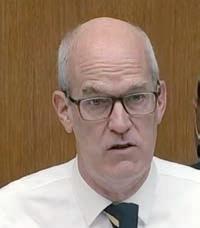
Congress has until September 30 to get a bill done. “There’s a long way to go between here and there as we swear in a new Congress,” Bolen acknowledged. “But we have a lot of people in leadership roles who have been around for a long time.” He noted leaders in both the House and Senate have long backgrounds in steering aviation policy on Capitol Hill. In addition to Graves and Larsen, this also includes Garret Graves (R-Louisiana) who was set to take over as chairman of the House aviation subcommittee after serving as ranking Republican. In the Senate, where the
Democrats retained control, Sen. Maria Cantwell (D-Washington) is anticipated to remain chair of the Commerce Committee, which also has jurisdiction over FAA reauthorization.
“There are people who are very familiar with the FAA process and hopefully they will make the passing of a good bill and a strong bill a real priority and imperative,” Bolen added.
Beyond authorizing the FAA for five years (or whatever period lawmakers ultimately choose), the bill will touch on myriad issues of importance to all of aviation.
While the legislative package is still taking shape, lawmakers have provided clues about what might be in it.
Speaking during a Honeywell Air Mobility Summit in Washington, D.C. in September,
At American Aero, service is a verb. A constant state of action. Every day, with every interaction. Our mission is to be exceptional.

RICK LARSEN REPRESENTATIVE (D-WASHINGTON)
I do think we need to take [WAI recommendations] seriously and see how we can turn those into legislation.
Larsen said he expects that the upcoming bill would contain a separate title on advanced air mobility (AAM) to make sure that the FAA is properly organized to focus on the regulatory and operational requirements in a timely fashion. The FAA has been pressing to release operating and training guidelines that will facilitate the use of AAM in commercial operations in time for the entry-of-service of the first vehicles, roughly in late 2024.
Larsen expressed concern that the agency has looked at AAM as a research and development project and stressed that “it’s not R&D.”
AAM safety must be addressed, he said, but also noted a range of other issues such as electric charging stations and vertiport infrastructure. In fact, AAM is such a growing issue, Larsen quipped that the 2028 reauthorization bill could be an AAM bill.
Garret Graves (who is not related to Sam Graves) agreed and further stressed that Congress needs to ensure that the FAA modernizes its approach so it is not applying a 1970s approach to regulation to 2030s technology.
In addition to an entire title of the reauthorization bill dedicated to AAM, Sam Graves said that, for the first time, the upcoming bill likely will have a title dedicated to general aviation. Graves said such a section would address issues specific to the sector, but importantly “bring more attention to general aviation.” This includes highlighting the sector and the roles it plays.
One such issue that could find its way into a general aviation section is privacy. This has become a larger issue as flight trackers have followed aircraft and used those movements to “flight shame” celebrities and other high-profile individuals.
“We believe strongly that no person should have to give up their right to privacy just because they’re getting on a general aviation airplane,” said Bolen, who raised the issue during testimony before congressional panels late last year. “That’s something we’ve stressed with Congress, and Congress has supported the idea that there should be a right to privacy.”
REP. SAM GRAVES REPRESENTATIVE ( R-MISSOURI)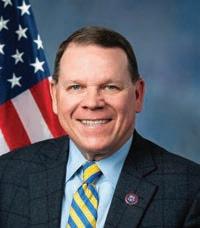
remains open to ideas. “It’s been driven home…the workforce challenges that we have out there in aviation,” he said.”
As is typical, the reauthorization bill will have a significant focus on safety. But this time it will be especially so in the aftermath of the Boeing Max crashes and the number of mandates Congress passed surrounding certification and training. There have also been challenges created on that front, especially in light of a constrained and aging FAA inspector workforce and the complications brought on by the pandemic.
Sam Graves also acknowledged the importance of the issue saying, “absolutely…we have to have privacy.” He expressed concern that privacy has not been adequately protected. “Today, it’s so easy to get on the internet to track, see where [someone] is going. That obviously creates problems for individuals.”
Other issues that may be included could involve sustainability and efforts to eliminate lead in aviation gasoline, airport and community involvement, and other concerns that pilots and general aviation operators are facing.
The reauthorization bill further is anticipated to continue to highlight workforce issues. Larsen noted that some of the recommendations released last year from the Women in Aviation Advisory Board were legislative in nature and worth exploring. In addition, the Youth Access to American Jobs in Aviation Task Force has further recommendations. “I do think we need to take [those] seriously and see how we can turn those into legislation,” he said.
Sam Graves further said that the committee is focused on workforce and
Testifying before Congress, General Aviation Manufacturers Association president and CEO Pete Bunce has underscored the issues involving the growing backlogs at the agency, as well as the issues surrounding turnover there. The reauthorization bill, Bunce said, “should place an emphasis on ensuring that FAA has the workforce, training, and skills to improve the certification process and keep pace with industry innovation.”
He further discussed the need to improve the regulatory process to reduce the backlog of technical standards, policy memos, orders, and advisory circulars. “It is important that the bill advances the aviation system with a positive impact on safety, innovation, competitiveness, aerospace jobs, and the manufacturing and maintenance industry,” Bunce said.
Sam Graves further stressed his belief that the FAA once again should focus beyond enforcement to advocacy. “We have to introduce advocacy back into [its] mission statement because we’re not advocating for this industry.”
But to make sure the FAA needs to catch up with its backlog of work, Garret Graves noted that Congress also needs to be thoughtful about what it assigns to the FAA in the upcoming reauthorization bill. Graves said Congress should streamline its mandates to the FAA and eliminate outdated or unnecessary requirements to make sure the agency has the capacity to address
most pressing issues. z
the
Today, it’s so easy to get on the internet to track, see where [someone] is going. That obviously creates problems for individuals.


Lightspeed unveiled its newest pilot headset, the Delta Zulu, in September 2022, and since then I was able to test it in a typical piston airplane and in a single-engine turboprop. The Delta Zulu is similar in size and configuration to Lightspeed’s Zulu 3 but adds more active-noise canceling (ANR) technology and a unique audio equalization system as well as a carbon monoxide (CO) sensor.
For comparison purposes during these flights, I tried the Delta Zulu and a Bose A20 ANR headset. It is admittedly a somewhat subjective test, but I found the Delta Zulu to be quite comfortable and with excellent noise-canceling.
Either headset does a great job of canceling noise, but the added features of the Delta Zulu might make it more attractive. This iteration of the Delta Zulu includes Lightspeed’s Kanari “smart alert technology” sensor, which measures CO levels in the wearer’s vicinity. The headset’s audible alerts warn when it detects CO above caution and critical levels. Pilots can also view CO levels and history on the Lightspeed app.
With the HearingEQity audio equalization system, pilots can run a 12-frequency hearing test while wearing the Delta Zulu headset connected via Bluetooth to the app. Once


completed, the audio equalization system sets the hearing level in each ear cup “to create your individual hearing profile to compensate for any hearing variations between ears,” according to Lightspeed.
I flew with the Delta Zulu headset on two flights, one in a Cessna 172 and another in a Daher Kodiak 900 single-engine turboprop. On both flights, I swapped between the Lightspeed and Bose A20 to try to compare them. I wasn’t able to perceive a distinct difference in hearing quality and ATC communications were clear with both. The Lightspeed headset did feel like it had less clamping pressure on my head, and I liked the way it easily accommodated my eyeglasses. The Delta Zulu is priced at $1,099. M.T.
•
•
•
•
•
•

As NBAA rolled out its Sustainable Flight Department Accreditation program, the organization strived to take a holistic approach toward sustainability. Electric aircraft, sustainable aviation fuel (SAF), and more efficient flight operations and aircraft are widely viewed as central steps for a greener path. But industry leaders also readily agree that they are among numerous steps that companies can take toward a more sustainable future and that all organizations can take some of these actions.
In fact, NBAA’s inaugural class of the audit-based program reflects that with registrations in areas of ground support, infrastructure, and operations, along with flight. Aviation entities are organizing their efforts, aligning with parent organizations, and learning what their companies already have that they can take advantage of in their quest for sustainability, said Stewart D’Leon, NBAA director of environmental and technical operations for NBAA.

“We’ve been delightfully surprised with some of the strategies, what they’re putting together, and what they’re doing and the goals they’ve set,” D’Leon said of the accreditation applicants.
Flight departments that have approached their parent organizations on accreditation have found this is being well received because their company leaders are also looking at their carbon footprints.
“Their leadership is saying, ‘that’s really great because we were trying to figure out how to connect with the various divisions,’” D’Leon said, adding this is exactly what NBAA hoped could be a result of the accreditation program—facilitating “real”
connections. “And, I’m delighted to say that a few of the flight departments have become the golden children of the organization because they’re leading the charge.”
Emily Tobler, manager of accreditation and environmental at NBAA, agreed. “We’ve got some folks who are now leading the charge for their organizations, but I think there’s also just been a lot of mutual discovery [that] each other exists and [they] can

help each other accomplish the same goals.”
The program has “put a lens” on those conversations and about other elements of sustainability, Tobler said. “Talking about propulsion systems and specifically our carbon impact from jet fuel is top of mind for everyone. But there’s a lot of other conversations that are going on here about waste management and about energy,” she said.
For example, Tobler noted flight departments have had conversations about never seeing a utility bill in the time they’ve owned or leased hangars but believing they can help resource renewable energy. Now they are developing relationships with
“We’re all learning as an industry,” D’Leon furthered.
NBAA’s accreditation program is just one of numerous programs available on the sustainability front. The National Air Transportation Association has a Sustainability Standard for Aviation Businesses program, and the European Business Aviation Association developed a Standards & Training for Aviation Responsibility and Sustainability (STARS) initiative that’s modeled after an Airports Council International initiative, among others.
Whether through accreditation, another industry program, parent company collaboration, or forging an individual path, Scott Cutshall, Clay Lacy Aviation’s senior v-p of development and sustainability, advises that organizations should “just start.”
Cutshall has provided numerous presentations, including at AIN’s own Building A Sustainable Flight Department regional forums held in 2021 and 2022, on how
industry organizations can move forward. The first thing he tells people is to think broader than the environment and think about what’s doable.
“When someone says sustainability, most people in their mind immediately go to environmental. But there’s also the social aspect and the economic aspect of sustainability. You can take a bunch of actions to be very environmentally friendly, but if that causes economic harm to the company, eventually the company won’t be around to be environmentally friendly,” Cutshall said.
He noted the many questions he receives on cost and said, “if it costs too much, then just don’t take that action. But what about the seven other actions that don’t cost anything? I think the first thing I tell people is you have to take a holistic view and there are 5,000 things I can do to be environmentally friendly and more sustainable.”
The industry is not asking organizations to jump into all sustainable means immediately, but rather “just start. If every company just started taking action on operating more sustainably, then the collective impact would be enormous.”
To begin with, companies can determine what their Scope 1 and Scope 2 emissions are.
“It’s kind of like when you decide to exercise,” he explained. “If a person wants to lose 10 pounds they have to get on the scale to see where they are and whether they will achieve their goal down the road.
By stepping on the scale—[to determine] your Scope 1 and Scope 2 emissions—then you know where you are and then you can start to make plans to reduce them.”
Cutshall noted that a lot of resources are available to help accomplish that task. “If somebody was to Google how to measure my carbon footprint, there’s a lot of resources out there.” In addition, NBAA has been developing management resources to help walk organizations through such efforts.
SCOTT CUTSHALL CLAY LACY SENIOR VICE PRESIDENT
That makes a company carbon-neutral from the beginning. However, he stressed the offsets are not the end solution. “It’s intended to be a bridge,” because the company has not yet reduced its emissions.
Step two is looking at how to reduce emissions. “Ideally we would eliminate our emissions completely,” Cutshall said, but acknowledged that is a long-term goal. In the interim, organizations should ask what options are widely available or that can be implemented more immediately.
“If I’m looking to reduce my electricity, can I put motion sensors so that if somebody leaves a room and forgets to turn off the light, it goes off automatically? Can I change light bulbs to LEDs because we know LEDs burn less electricity than incandescent bulbs or fluorescent bulbs,” he suggested.
Generally speaking, Scope 1 involves direct emissions derived from an organization’s own facilities and vehicles or controlled sources. This could be fuel burned from ground equipment, heating oil used in facilities, or even an FBO’s courtesy vehicles, Cutshall explained.
Scope 2 is indirect emissions from purchased energy, such as electricity. Beyond that is Scope 3, which is less in control of an organization but represents emissions that occur in a company’s value chain both upstream and downstream.
Once an organization can determine its footprint—Cutshall said to focus on Scope 1 and 2 because 3 is not in direct control of the company—“the first thing that everybody can do is offset those emissions. They can buy carbon offsets to offset those emissions.”
Cutshall added that FBOs may not be able to reduce ground vehicle use, but may be able to look at renewal diesel, which is “a drop-in fuel. You don’t have to change your trucks, you don’t have to do anything. You’re just buying a different product.” Further, he continued, “If you have courtesy vehicles, can you replace one with an electric vehicle? [Can you] get rid of single-use plastics with things that are compostable and recyclable?”
The bottom line, Cutshall said, “There are lots of ways to reduce your emissions. And the goal is once you know what your emissions are, you’ve taken actions to reduce your emissions, then you offset what’s left over and then you start the process over again.”
The idea is to decrease emissions over time so the amount that is offset gets smaller and smaller every year. “The holy grail is I don’t have to buy offsets anymore.”
Clay Lacy began taking this approach in 2019, putting together a three-year plan on steps it would take to reduce its emissions.
True to his advice, Cutshall said its efforts have not been a “huge financial burden on the company.” Most of the costs have surrounded the time and energy focused
When someone says sustainability, most people in their mind immediately go to environmental. But there’s also the social aspect and the economic aspect of sustainability...
on transitioning to greener options. As an example, Clay Lacy has switched a couple of locations from diesel to renewable diesel. The costs were the same. “There was zero financial impact to the company, but it significantly reduced our emissions,” he said.
It also has transitioned some ground service equipment to electric, activated a 500-kW solar array at its headquarters, sourced renewable resources for its electricity at its John Wayne Airport facility in California, offered carbon offsets for its management clients, sold SAF to clients, conducted a waste recycling program, and changed from plastic water bottles to boxed water, among other e ff orts. It was certified as a member of the Environmental Protection Agency’s Green Power Partnership and it gets the claim to be the first recognized under NATA’s Sustainability Standard for Aviation Businesses program.
Cutshall said the benefits of these efforts
have been tangible. The company has lowered its emissions by 35 percent.
As importantly, the aviation business chain is seeing a culture shift. “More and more people throughout the company are wanting to contribute to the company’s actions. And I think that’s a great thing to see the buy-in from people,” he said, adding they are pitching in on new ideas.
Another significant benefit has been recruiting. “When we ask candidates that are in the interview process, ‘what attracted you to Clay Lacy,’ we’re starting to hear, ‘I saw that you have a sustainability program.’ So, from a recruiting standpoint, it’s something that job seekers are starting to pay attention to.”
Jo Damato, senior v-p of education, training, and workforce development for NBAA, agreed that sustainability initiatives are bringing benefits in workforce development. “We’re definitely seeing this conversation connecting the generations and actually showing that we are looking to our new entrants into the field to help us and to educate us because they’ve been exposed to this at a much earlier time than we have. Within the industry, it seems to be one of the main conversation starters.”
If the industry is going to attract new people, then it must consider value alignment, Damato continued. “A lot of our young people really know…what are my values and how am I willing to spend my 40 hours a week plus with an organization I know is amplifying my values versus crushing them. I think they’re looking at that.” Those looking at a career in business aviation want to reconcile their passion for environmental concerns and sustainability. “They’re figuring out how to marry those things and they’re getting excited about it,” she said.
NBAA’s D’Leon added: “We’re all on an even playing field. So whether you’ve been in this industry for 40 years or you’re just stepping into this industry, we’re all really
STEWART D’LEON NBAA DIRECTOR, ENVIRONMENTAL OPERATIONS
learning and coming up at the same time, which gives us the opportunity to come to the table from a variety of generations within our career fields and all have a seat at the table and be leaders in this space.”
Along those lines, Clay Lacy’s Cutshall provided another piece of advice. “You don’t have to do it alone. There’s a lot of resources.” Pointing to the NBAA program, he said, “even if you decide not to go through the accreditation, [the association] published the complete blueprint of how to start acting more sustainably. NATA has a sustainability audit checklist that you can go download from their website for free.”
Cutshall pointed out that business aviation is a community. “Call other people in the industry and ask, what are you doing?” But bring others to the table both within and outside the organization, he said. z

...we are looking to our new entrants into the field to help us and to educate us because they’ve been exposed to this at a much earlier time than we have.
... whether you’ve been in this industry for 40 years or you’re just stepping into this industry, we’re all really learning and coming up at the same time...
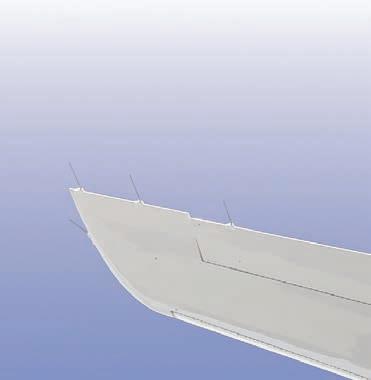
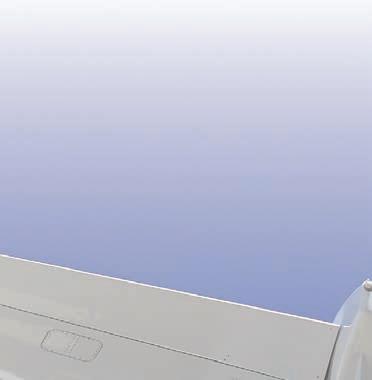

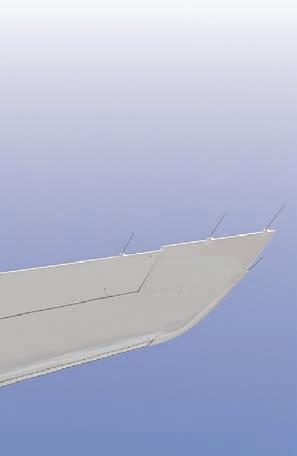

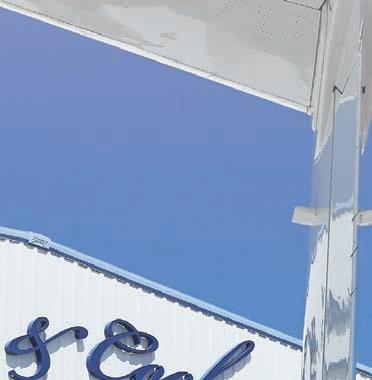



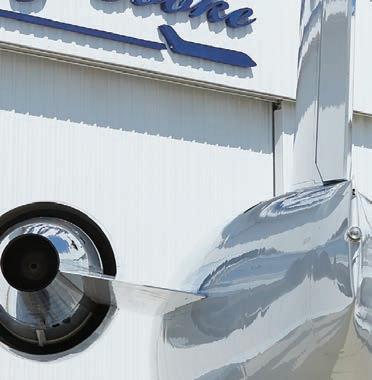





















The European business aviation industry has been caught in the crosshairs of a burgeoning, vocal, and increasingly influential environmental community that regards the use of private aircraft as a polluting luxury that the planet can ill afford to accommodate.
Of course, business aviation is no stranger to such opprobrium having faced a barrage of bruising assaults over the years from activists, adversarial politicians, and their erstwhile media cheerleaders seeking to negatively—and incorrectly—portray business aircraft as toys for the super-rich and symbols of extravagance and excess.
“We have become accustomed to negative publicity and have always challenged our critics head-on by presenting clear facts about the industry and the invaluable role it plays,” said Robert Baltus, chief operations o ffi cer for the European Business Aviation Association (EBAA).
He admitted, however, that the industry is on particularly high alert today and its detractors are as tenacious as ever. “There are a number of vocal environmentalists that have had business aircraft in their sights for some time and like to put our industry in the corner where it doesn’t belong,” Baltus conceded.
Crucially, their voices are amplified in the current climate, “where the aviation sector’s carbon footprint is being scrutinized like never before,” and the pandemicrelated uptick in business jet travel has thrown the issue into sharper relief, he noted.

Hostility towards business aviation in Europe has manifested in a cacophony of protests by activist groups at airports and private aircraft terminals throughout the continent. These included the coordinated demonstrations and “sit-ins” last November
to coincide with the United Nations climate convention being held in Egypt.
Groups including Extinction Rebellion and Scientist Rebellion hit out at the scores of UN delegates who traveled to the COP27 conference by business jet and demanded a complete ban on their use, along with high taxes on airline frequent flyers. Protests included blockading the entrances to Farnborough Airport and the Harrods Aviation FBO at London Luton airport in the UK.
Similar protests were also staged at Milan Linate airport in Italy, while around 500 Dutch members of Greenpeace rode bicycles into the business aviation enclave at Amsterdam Schiphol airport and blockaded aircraft.
Calls to curb private aircraft use have been mounting since August last year when France’s transport minister Clement Beaune called for tougher regulation of the industry. President Emmanuel Macron and the country’s Prime Minister Elisabeth Borne subsequently requested concrete proposals for measures that could include bans on some flights and punitive taxes.
Other European countries including Belgium and the Netherlands are also mulling curbs on aircraft usage, said EBAA, while the UK government is facing calls to impose a 10-fold increase in the air passenger duty for private charter flights.
Branding business jets as “hugely damaging to the environment and the preservation of the super-rich,” environmental transport group the Campaign for Better Transport wants business aviation to lose its current exemption from the country’s 20 percent value-added tax (VAT) and for this levy to be imposed on every aircraft movement regardless of flight duration.
“This assault on business aviation is creeping into several countries in Europe and it’s not going to go away,” said EBAA secretary general Athar Husain Khan. “The industry is in this for the long run—a marathon rather than a 100-meter sprint, so to speak,” he added.
The Brussels-based trade association suggests the unwelcome spotlight on business aviation today has largely been triggered by the exponential rise in private aircraft travel as a result of the pandemic. A record-breaking 800,000 aircraft movements were conducted across Europe in 2022, EBAA claimed—100,000 more than the previous “normal” years.
generation of around 450,000 jobs, directly and indirectly.
Furthermore, Baltus said it is critical the business aviation industry reinforces the message of good and responsible stewardship of the environment and “has been working hard for more than two decades to move in the right direction on sustainability.”
Baltus points to the “pioneering” Business Aviation Commitment on Climate Change (BACCC) initiative, launched in 2009 with the aim of achieving net-zero carbon dioxide (CO2) emissions (relative to 2005) by 2050.
Industry groups including the General Aviation Manufacturers Association (GAMA) and the International Business Aviation Council have developed four guiding principles that provide a road map for ensuring safety, security, and sustainability. They include fostering investments to increase sustainable aviation fuel (SAF) production and availability; encouraging greater use of industry initiatives such as SAF book-and-claim; supporting innovations such as electric-powered aircraft and other technologies that cut CO2 emissions; and championing cooperative programs to increase aviation sustainability.
“The perception is that business aircraft are flown by rich people for frivolous journeys, but in reality, most are deployed on medical, humanitarian, urgent cargo, headof-state, and business-related missions,” said EBAA’s Baltus.
Business aviation leaders will continue to engage with policymakers at local, national, and the European level, he continued, to educate and present the case for business aviation in Europe. Baltus pointed to the industry’s € 100 billion ($95 billion) in economic output and
“We committed in 2009 through the BACCC to reduce greenhouse gas emissions of the global business aviation fleet by 2 percent year-on-year by 2020, which we achieved, recording a fall of over 7 million tonnes of CO 2 over that period,” commented Kyle Martin, GAMA’s vice-president of European affairs. “We renewed that pledge in 2021 and continue to slash CO2 by 2 percent annually.”
These achievements have been met in part through efficiencies in powerplants and aircraft designs including aerodynamic refinements, the use of composite structures and other lightweight materials throughout the aircraft, and improvements in avionics systems such as wider adoption of synthetic vision and head-up displays which allow aircraft to avoid weather delays.
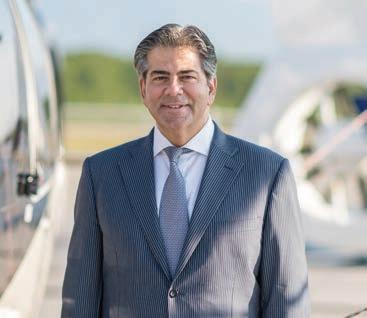
This assault on business aviation is creeping into several countries in Europe and it’s not going to go away... Athar Husain Khan, secretary general, European Business Aviation Association.
“Business aviation has long led the charge in the aviation industry on technological development, investing billions in R&D to create enhanced, efficient, sustainable, safe, and desirable products. Today is no different,” said Martin.
His view is supported by Marc Bailey, chief executive of the British Business and General Aviation Association. Bailey suggests the industry’s message must focus on its commitment to developing and implementing sustainable technology if it is to win over its critics.
“We have a target on our backs,” he exclaimed. “While there is still a place in certain quarters to promote the benefits of private aviation as ‘time machines’ and ‘tools for growing businesses and economies,’ this argument is just not going to wash any longer in this environmentally sensitive climate.
“To win the argument today we have to demonstrate how our industry is charting the pathway towards a decarbonized future,” Bailey added, “and there are plenty of examples.”
He points to the developments of alternative propulsion systems—hydrogen fuel cells, hybrid-electric and full-electric—which have a clear path to their application in aerospace. Programs such as the Ampaire Eco Caravan (hybrid) and Eviation Alice (full-electric) notched their first sorties in 2022, while companies like ZeroAvia are closing in on this milestone with its hydrogen fuel-cell-based powertrain. Developments in electric and battery technology are also driving a plethora of small electric vertical take-off and landing aircraft that are expected to come online before the end of the decade.
“We now need to roll up our sleeves and create the infrastructure and regulatory environment to bring these programs over the line and into service as soon as possible,” said Bailey.
So far, business aviation’s decarbonization efforts have largely been ignored by climate activists.
Critics of private aircraft flying frequently take aim at the high carbon burn per passenger compared with a regular commercial flight, acknowledged Glenn Hogben, chief executive of the Air Charter Association (ACA). “The narrative is often focused on the environmental cost per passenger, and while we acknowledge that the carbon burn for a business aircraft user is comparatively higher than that of a commercial aircraft passenger, it is important to emphasize that the industry contributes only 0.04 percent of global greenhouse gas emissions annually,” said Hogben.
Despite the negative rhetoric, business aircraft operators and flyers are “environmentally conscious,” he insisted. To support this claim, Hogben pointed to a recent survey of ACA members in which more than 70 percent pledged to become net zero operations by 2032.
“Already more than half of the charter flights provided by our members use verified carbon offset programs to cover the emissions, and almost 70 percent are offsetting higher than the emissions on that flight,” said Hogben.
With the availability of SAF—a lower carbon alternative to jet fuel—still patchy in Europe, book-and-claim programs are becoming increasingly popular. This initiative allows operators to purchase SAF at an airport where it is unavailable and receive credit for its supply and use at one where it is. “While there is no single solution to reach net zero, SAF is critical because it works to reduce CO2 emissions now,” said Hogben
Unfortunately, global SAF supplies are less than 5 percent of aviation fuel demand, he noted, and SAF is far more expensive than conventional jet fuel.
GLENN HOGBEN CEO, AIR CHARTER ASSOCIATION
“With the right market incentives that encourage investment in production and wider use, the cost will come down significantly,” said Hogben.
Furthermore, the SAF blend cannot be more than 50 percent under current regulations, although Gulfstream in December became the business jet manufacturer to fly one of its aircraft on 100 percent SAF.
While the industry is committed to playing its part in the global decarbonization drive, it believes Europe’s legislators must also step up, and urgently progress the long-delayed Single European Sky (SES) project.
Operators have expressed increasing frustration at the lack of efficiency and continued fragmentation of Europe’s air traffic control services, which means their aircraft are flying longer than necessary routes.
Baltus said efforts by the European Commission to streamline the erratic network of national air navigation service providers and air traffic control centers have consistently faced roadblocks from some member states—notably France and Germany, which jointly control a large part of the continent’s airspace—that want to retain sovereignty over their airspace and the revenues it generates.
“SES has become too political, which is a shame,” admitted Baltus. “Implementing SES will allow seamless, direct routings meaning less time in the air, less inconvenience, lower costs and vitally, a reduction in CO2 emissions.”
Business aviation has come under increased scrutiny in Europe for its contribution to emissions. Social media has pointed to flights of British royals, France is pushing to curb private jet operations, and environmentalists have staged protests at airports.
However, these events have not taken into account the myriad initiatives underway throughout Europe to improve the sustainability of business aviation operations. Many believe that Europe has been a leader in sustainability initiatives and that it is making progress.
Key among the initiatives is the uptake of sustainable aviation fuel (SAF), which has a significant potential to reduce aviation’s climate impact through its lifecycle benefits. While the European Union Aviation Safety Agency (EASA) noted that the current SAF supply remains low—less than 0.05 percent of total EU aviation fuel use— the EU is taking steps to change that.

As part of the EU’s “Fit for 55” goals (to reduce EU emissions by at least 55 percent by 2030), the European Commission proposed a regulation to boost the uptake
of SAF through the “ReFuelEU Aviation” initiative.
“In order to meet the EU’s climate objectives, the proposed rules set out EU-level harmonized obligations on fuel suppliers and aircraft operators for scaling up SAF used for flights departing from all EU airports above a certain traffic threshold,” EASA said. “According to the regulatory proposal, fuel suppliers would be required to blend 2 percent of SAF by 2025, 5 percent by 2030, and at least 63 percent by 2050, and operators would be required to use the SAF-blended fuel available at EU airports.”
SAF, which can reduce lifecycle CO 2 emissions by up to 80 percent, is becoming more widely available at UK business airports, affirmed the British Business and General Aviation Association (BBGA). “And where it is not available, initiatives like book-and-claim, enabling customers to access SAF carbon reductions without being physically connected to the supply site, help to broaden its reach,” BBGA said.
The association further noted that last July, “Farnborough Airport announced its commitment to be net zero across its controllable emissions by 2030 or sooner, which will result in a 91 percent reduction of those emissions.” Ahead of the Farnborough Airshow that took place July 22-26, the airport offered SAF at the same price as standard jet-A fuel. This offer began on July 1 and continued to the kick-off of the airshow.
However, as progress is being made, the British Helicopter Association (BHA) cautions that sustainable fuels are still not economically practical. “There are perhaps only a couple of refineries in Europe and none in the UK producing SAF, so there is a transportation problem in addition to a stocking problem,” BHA said.
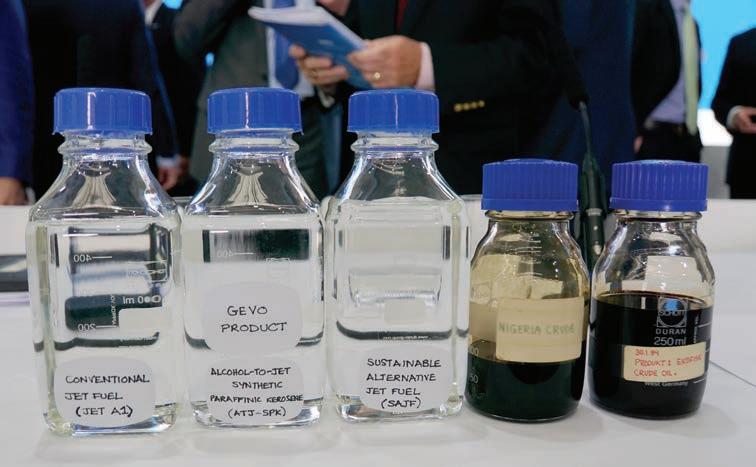
The main constraint of scaling up the use of SAF is the price differential between fossil kerosene and SAF, observed EASA. “As a part of the discussions around the ReFuelEU regulation, a flexibility mechanism is being considered in the way aviation fuel suppliers can fulfill their sustainable aviation fuel supply obligation,” EASA said. “There are also proposals on the table to allow for additional free allocation of emissions allowances under the EU ETS for airlines to cover their compliance costs with ReFuelEU regulation.”
Another step towards sustainability in Europe has been the EU Emissions Trading
Scheme (ETS), which is a cap-and-trade system that sets a limited number of emissions allowances for aircraft operators and constrains the total amount of emissions of the sector. EU ETS is a cornerstone of the European Union’s policy to combat climate change and includes intra-European Economic Area (EEA) flights since 2013, EASA said.
The EU has provided exceptions for operators of aircraft with a maximum takeoff weight of less than 5,700 kg (12,566 pounds), commercial air transport operators with fewer than 243 flights in each of three consecutive four-month periods, commercial operators with annual fossil emissions lower than 10,000 tonnes of carbon dioxide, or non-commercial operators with annual fossil emissions lower than 1,000 tonnes of CO₂.
“The total number of emissions allowances is limited [capped] and decreases over time through a linear reduction factor, thus ensuring that the objective of an absolute reduction of the level of CO2 emissions is met at the system level,” EASA maintained.
The UK is also implementing its own ETS, BHA said. “We are in step with the EU ETS. The UK ETS carbon offsetting targets are around 5 percent more stringent. It is important that UK operators do not get out of step, or else they would be put at a disadvantage,” the association said. “It should be observed that VFR flights sit outside the scheme. In effect, most airplanes and helicopters over the weight limit and doing commercial flights are also doing IFR. However, for the air ambulance
According to the regulatory proposal, fuel suppliers would be required to blend 2 percent of SAF by 2025, 5 percent by 2030, and at least 63 percent by 2050, and operators would be required to use the SAF-blended fuel available at EU airports.
helicopter sector, this is important as they are getting heavier helicopters, but their flights are VFR.”
As to the applicability of the EU ETS to business aviation, the European Business Aviation Association (EBAA) observed that larger fleets will slowly enter the ETS system due to their increased maximum takeoff weights.
EBAA, however, pointed out that business aviation has adopted the Standards & Training for Aviation Responsibility and Sustainability (S.T.A.R.S.) program, describing it as “an initiative with the goal of developing and introducing industry-wide sustainability standards and an accompanying label.” Set in motion by young aviation professionals, S.T.A.R.S. is designed to support, train, and certify business aviation organizations to sustainability and responsibility goals. “The program, supported by EBAA and the International Business Aviation Council (IBAC), will focus on the social and environmental issues addressed in the UN sustainable development goals,” EBAA added.
Outside of such organizational programs, BBGA observed that many of its charter operators have adopted a regular floating fleet model to fly more sustainably—where managed aircraft are available for charter from the destination at which they have just landed, versus returning to a set base. “Dedicated business aviation airports in the UK have overtaken air transport movements from London-centric airports—which share traffic with legacy and low-cost carriers—a reflection of the continuing popularity for on-demand flying, post-Covid. Our airport members are adding significant infrastructure improvements in a nod to sustainability,” said BBGA.

In March 2021, the UK Royal Air Force determined four veteran BAe 146 aircraft would be replaced by two more fuel-efficient Dassault Falcon 900LX aircraft, known in RAF Service as the Envoy IV, BBGA further highlighted. “Positioned out
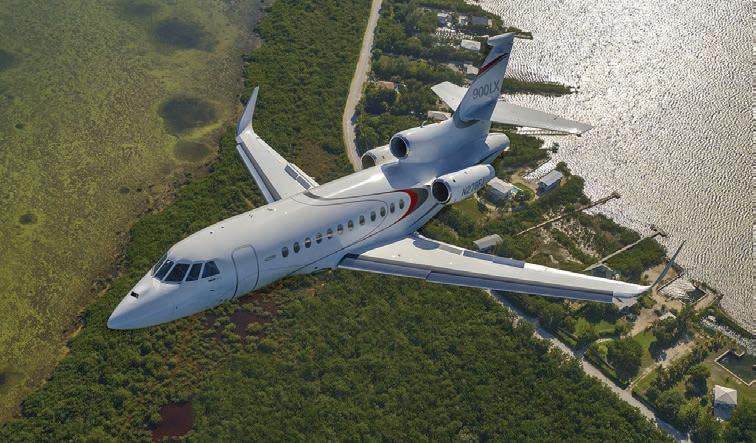
The UK Royal Air Force is replacing BAe 146s with more e cient Dassault Falcon jets for government transport duties.
of RAF Northolt, these aircraft were in the public eye in early September 2022, ferrying outgoing and new prime ministers to and from Balmoral to meet the Queen and,
48 hours later, transporting Royal Family members between England and Scotland immediately following the passing of HM Elizabeth II,” the association noted.
According to EBAA, looking to the future it is important not only to mitigate the environmental impact of the sector through taxation schemes but also to allow the industry to invest in sustainable technologies, a trend that is already happening.
In terms of research on novel aircraft technologies, Clean Sky 2 (2014-2024), which is part of the EU Horizon 2020 program, has a combined public and private budget of just under € 4 billion (comparable to U.S. dollars), observed EASA. “It aims to develop, demonstrate, and accelerate the integration of technologies capable of reducing CO2, NOx, and noise emissions,” said EASA. “Aircraft and engine environmental certification standards (ICAO Annex 16, Volumes I, II, and III) are implemented by EASA within the EU and European Free Trade Association. The engine NOx/nvPM standards, and the aircraft noise/CO 2 standards, define the design space for products to simultaneously address noise, air quality, and climate change issues.”
According to BBGA, the increased use of digitalization has greatly benefited business aviation, saving time and improving
efficiency with paperless solutions. “Our UK members have been among the most creative in identifying useful solutions, drawing on their founders’ experiences as charter brokers, operators, [and] engineering heads,” BBGA maintained.

The association pointed out digital efforts of companies such as Scotland’s Make TechFly’s Avionexus, which enables real-time updates and data exchange, employing bank-level cybersecurity to manage every aspect of a trip; Elms Aviation, which uses a secure cloud-based platform to manage compliance; and Air bp’s Airfield Automation Safe2go digital technology that provides an additional technological barrier to help prevent misfueling and enhances efficiency and reliability in refueling operations.
EASA has recently published rules whereby air operators can be allowed to reduce the amount of fuel carried during operations, thereby reducing the CO 2 emissions of the overall flight and the environmental impact of the flight.
“Aircraft are required to carry enough fuel to ensure the safety of operations in case their flight plan needs to change for
reasons that could include the delays on approach to the destination airport or even the impossibility to land due to weather considerations or other issues. Carriage of this extra fuel, as it adds weight to the aircraft, increases the fuel consumption and total emissions from the flight,” EASA said. “The amount of additional fuel required can be optimized, while continuing to ensure high safety levels, due to improved risk assessment, calculations based on better data, and better decision-making.”
The regulatory package is aligned with ICAO guidance. EASA, however, advised that the rules will require national authorities to adjust oversight to ensure safety levels are not compromised and that the exact reduction in fuels would vary by route and aircraft.
EASA highlighted the success of these initiatives. EU ETS alone (including the commercial sector) is estimated to have reduced net CO2 emissions by 159 million tonnes from 2013 to 2020—or by the amount of the emissions in the Netherlands in 2018— including through funding of reductions in other sectors. Further, Clean Sky 2 aims at CO2, NOx, and noise emissions by 20 percent to 30 percent compared with 2014 aircraft technology, and new aircraft designs certified in the past year have a cumulative noise margin that is 5 to 15 EPNdB below the latest ICAO Chapter 14 noise standard.
BBGA believes the business aviation sector is continuing to show itself as resilient and creative. “Despite the pandemic, investments continue to be made on sustainability. Our new government is going to put it at the top of its agenda, likely advocating a changing face of fuel/energy management in the short term,” said BBGA. “This is a marathon, not a sprint. Fortunately, we have evolved to be a dependent advisor to the UK Civil Aviation Authority and government, as well as our 180-strong membership.” z
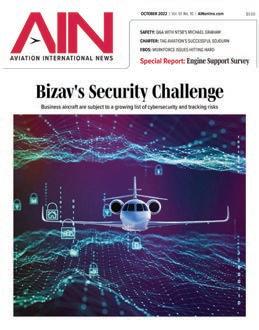

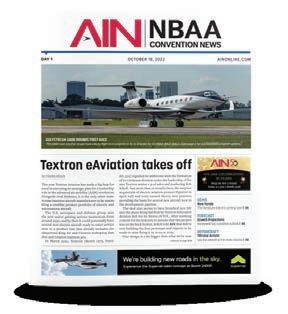

AIN Media Group o ers a suite of solutions to serve the unique needs of modern aviation marketers. Design customized programs with targeted audience creation and strategic campaign insights across live events, digital and print.
To learn more about how to tap into our targetable aviation audience of over 800,000, please go to: marketing.ainonline.com



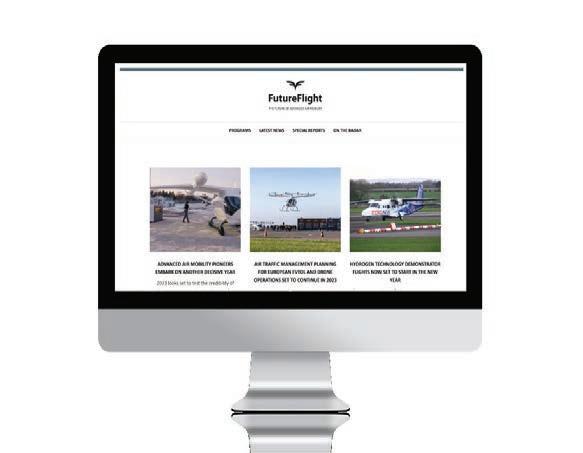
For nearly six decades, the FAA has required all air carriers to conduct continuous evaluations of their maintenance programs. Specifically, regulations require air carriers and commercial operators—both Part 121 and 135 (for aircraft with more than 10 passenger seats)—to establish a continuing analysis and surveillance system (CASS) to monitor, analyze, and optimize the performance and effectiveness of their maintenance and inspection programs.
The regulations (14 CFR 121.373 and 135.431) that define CASS are performance-based. According to FAA AC 120-79A, a performance-based regulation is a regulatory approach that focuses on measurable outcomes, rather than prescriptive processes, techniques, or procedures. This perspective leads to defined results without a specific direction or instruction in the regulation regarding how to obtain those results.
CASS is an element of a continuous airworthiness program (CAP). The FAA introduced CAP in 1964 as a response to safety concerns and “discoveries of weaknesses” in
air carrier maintenance programs revealed during accident investigations and FAA surveillance. A goal of CASS is to establish the highest possible degree of safety through data collection, corrective actions, and follow-up.

As defined, CASS is a quality assurance system and must consist of the following functions: surveillance, controls, analysis, corrective action, and follow-up. Combined, these functions create a closed-loop system to manage risk in aircraft maintenance much like a safety management system (SMS).
Established using performance-based regulations, a CASS is scalable and provides flexibility to meet the needs of different air carriers or commercial operators. As an example, a large Part 121 airline with more than 500 aircraft may leverage many different resources across its entire enterprise, whereas a smaller Part 135 charter operator with only 20 aircraft may adopt a simpler model that effectively accomplishes the same tasks.
CASS, as a quality assurance program, has demonstrated that it not only improves safety but can make a meaningful contribution to improving operational efficiencies; thus Part 91 or 125 operators may also benefit from CASS implementation.
Managing a mix of safety programs for both maintenance and flight operations for the business aviation operator can be a daunting task. Many of these safety systems and programs—all designed to improve safety by reducing risk—operate independently of each other with different software tools and workflows with little opportunity for “cross-talk” or overall system improvement.
Recently, Wyvern, the Nashua, New Hampshire-based aviation safety and risk management specialist, added a robust CASS module to its Quality and Safety Management (QSMS) software. Wyvern CEO Sonnie Bates understands the importance of integrating CASS within an SMS. “The FAA requires Part 121 and Part 135 operators

For 50 years, AIN has provided market-leading coverage of the most important airshows and conventions across the globe. In 2023, AIN is expanding its coverage with more events and more marketing opportunities. Drive awareness and consideration with a 360-degree marketing plan including print (where available), newsletters, and digital. Custom content opportunities are also available across all of our platforms.

January: Schedulers & Dispatchers | March: *Heli-EXPO, Sun n’ Fun, AEA | April: AERO Friedrichshafen May: *EBACE | June: *Paris Air Show, Aircra Interiors Expo | July: EAA Air Venture August: LABACE | October: *NBAA-BACE | November: *Dubai Air Show
Learn more at: marketing.ainonline.com/airshows-conventions
*Denotes Air Shows & Conventions with
with aircraft that have 10 or more passenger seats to implement a CASS. Through CASS, the operator is expected to identify aircraft technical issues, monitor and track those issues while looking for trends, and then apply mitigation strategies to correct the problems. They are also expected to follow up to make sure these corrective actions are effective. This is essentially what SMS does, but in a broader sense, capturing safety issues related to any aviation-related activity,” Bates said. “By integrating CASS and SMS, efficiencies are realized, complexity is reduced, simplicity increased, and workload optimized.”
The CASS module within Wyvern’s QSMS software is feature rich and was tailor-made to meet specific client needs. Alec Blume, Wyvern’s assistant v-p of risk management systems, is the architect of the new CASS module. “Like all QSMS functionality, the CASS feature was developed and grown organically, in response to the realworld needs of our busy clientele,” Blume said. “This feature, like all others, continues to evolve in unison with our operators’ systems.”
and reporting. Reporting features can be exported to both internal and external stakeholders (such as vendors or the FAA). The system uses multiple dashboards to visually present information to stakeholders.
To better understand the workflow of the CASS module and the integration within the QSMS software, we’ll review a typical aircraft maintenance activity at a business aviation flight department.
code) with operations procedures, operational limitations, and maintenance procedures assigned to that aircraft. This deferral was now a permanent record within CASS.
Of importance, for this operator, the FAA allows the flight crew to use the QSMS software (in lieu of a paper aircraft maintenance logbook), and maintenance control interacts with the actual logbook. This is a huge benefit because maintenance now has a consistent, standardized, and legible record. Plus, this removes a step in the workflow where a technician would have to transcribe the write-up into a digital format.
The QSMS Risk Management Module simplifies the process of determining root cause and testing what-if scenarios.
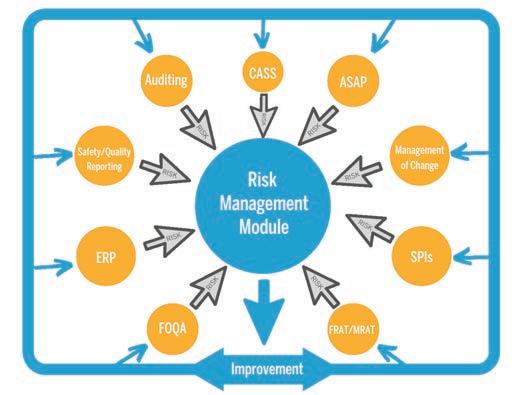
Blume further explained that by design, the CASS module functionally supports all elements of a CASS. “The methodologies that comprise QSMS workflows are perfectly suited to fulfill the requirements and expectations associated with CASS given that the same basic functional loop is being employed—surveillance, analysis, correction, and follow-up. It is the same idea.”
Wyvern’s QSMS software is comprised of two portals: an administrative portal and a user portal. The user portal is available on mobile devices and is designed to promote employee reporting and risk assessments by frontline employees. The admin portal is used to support administrative functions, such as analysis, assessments, remediation, follow-up processes,
In this example, a large business aircraft during its initial descent experienced a “generator fault.” The crew performed the QRH procedure that directed the crew to reset (OFF then ON) the affected generator. The crew was unable to reset the generator, so per the QRH they disconnected the integrated drive generator (IDG) and started the APU (for a second source of electrical power).
After landing, with the aircraft secured, the pilot entered the maintenance item in the post-flight briefing workflow within the QSMS/CASS software. The maintenance write-up was then emailed instantly to maintenance personnel (a maintenance controller in this case) and the IDG was deferred per the MEL (tagged by ATA
Prior to the next flight, the flight crew completed a pre-flight flight risk assessment, and the MEL information automatically populated with any restrictions that may have affected that flight. In this case, the operational limitation required the APU to be operated continuously, which increased the fuel burn and limited the maximum allowable cruise altitude. The flight crew then coordinated with its dispatcher for additional fuel to compensate for the flight at a lower altitude and with APU fuel burn.
Through the CASS surveillance process, an analyst discovered an increase in unscheduled maintenance items on this aircraft type. Further investigation, using the QSMS software (using an ATA code/ registration number search) revealed an increase in IDG failures. The analyst then worked with the quality assurance department and determined that these IDGs were overhauled by the same vendor. The vendor determined that the wrong oil seal was used on the IDG during the overhaul process—a corrective action was taken— and the operator continued to monitor IDG reliability as a follow-on activity.


From aircraft technicians to directors of maintenance, thousands of industry professionals are making preparations to attend the 2023 NBAA Maintenance Conference. Enhance your industry skills and take your career to new heights, as this must-attend event will provide an unmatched networking experience and the opportunity to hear directly from industry experts about the latest operational information and cutting-edge technologies developed for maintenance professionals.
This event will feature engaging education sessions and essential training courses, along with hundreds of exhibitors ready to share their latest advancements and innovations designed to provide attendees with the tools needed to succeed. Don’t miss out on this exciting event, and be sure to make plans to attend today!
On September 7, two-and-a-half years after the crash of a Yute Commuter Service singleengine Piper PA-32 near Tuntutuliak, Alaska, the National Transportation Safety Board (NTSB) released its probable cause finding on the five-fatality accident, citing a pilot’s decision to fly into potentially whiteout conditions. But a lengthy investigation also pointed to systemic safety issues and lax procedures that enabled the decision-making.
The PA-32 departed under a special VFR on the morning of Feb. 6, 2020, for the village of Kipnuk, less than 100 miles from the company base in Bethel. It crashed about 30 minutes later, at approximately 11:10 a.m. local time.
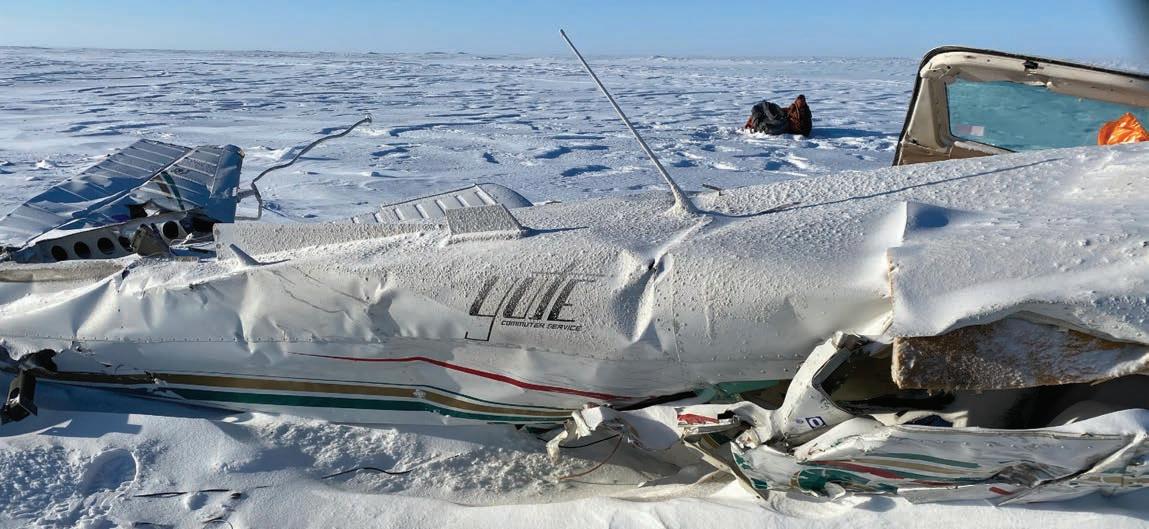
Investigators determined the decision of the pilot, Tony Matthews, to continue VFR into “reduced visibility, including likely flat light and/or whiteout conditions,” was the probable cause. Matthews had 645 hours of total time; the Kipnuk flight was only his
fourth revenue trip for the company.
As a contributory factor, the NTSB also found Yute’s operational control procedures were inadequate and “permitted” the pilot to depart below company minimums.
Yute is a VFR-only Part 135 commuter and air taxi. It primarily serves the southwestern Alaska region known as the Yukon-Kuskokwim (YK) Delta. The area is notorious for challenging winter weather conditions, with snow, fog, and winds prevalent throughout the season. Flat light is a common hazard.
When an investigator asked to describe what it was like, Yute’s chief pilot Byron Paul was blunt: “…the ground’s the sky and the sky’s the ground,” he said, “[that] is the only way I can tell you.”
The Kipnuk flight departed Bethel at 10:42 a.m. Twelve minutes earlier, as Matthews was taxiing out, the weather was 600 feet overcast with four miles of visibility in mist. At 10:43 a.m. there was a special
observation with the ceiling still at 600 feet overcast but visibility down to one and one-quarter miles.
A special issued two minutes later reported the ceiling at 800 feet overcast and five miles visibility, then at 11:05 a.m., it was back down to 500 feet overcast and three miles.
In Kipnuk, 40 miles from the accident site, conditions were 600 feet overcast with nine miles of visibility in light snow at 10:56 a.m. In the next hour, both Bethel and Kipnuk had worsening conditions. Visibility went down to one-half mile, and the ceiling measured as low as 400 feet with light snow, mist, and freezing fog.
Many of the villages in the YK possess limited weather reporting options. Some have no weather reportage at all, some have no certified weather available, and others suffer from technical difficulties including chronic telecommunication outages rendering the equipment useless.
The 2021 FAA Alaska Aviation Safety Initiative found that, “most rural airports do not have weather reporting systems. Without certified weather reporting, or an approved alternative with adequate fidelity, by regulation, Part 135 operators cannot conduct IFR operations into these airports.”
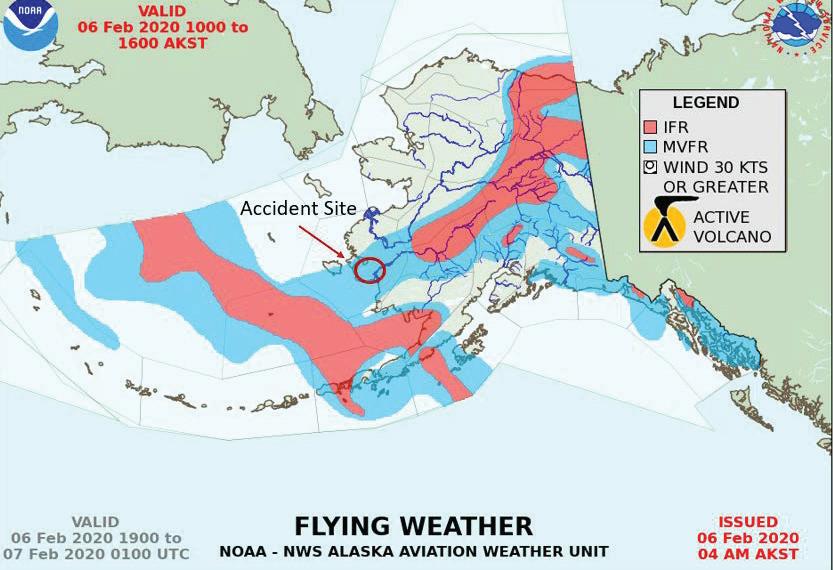
Attempts to reach Yute Commuter Service for comment on the decision to dispatch the flight were unsuccessful.
The NTSB interviewed eight Yute employees in the course of its investigation. In all of these interviews, Wade Renfro, the company owner, president, and general manager was present and permitted to ask questions of the interviewees.
The investigation largely focused on three things: lack of coherent policy establishing company minimums and individual pilot limitations, the flight’s missing risk assessment form, and the manner in which daily operational control functioned.
The two individuals who commonly held operational control were often physically absent from the office. Renfro lived part of the year 360 miles away, in the town of Soldotna, and director of operations (DO) Tony Spangler resided part of the year in Las Vegas. The other two individuals who could be delegated with the authority, chief pilot Paul and Ernie Turrentine, a senior pilot and former chief pilot, both flew the line and rarely exercised the responsibility.
On the morning of the accident, Renfro held operational control and phoned in at about 7 a.m. from Soldotna. Spangler was in Las Vegas; Turrentine and Paul were scheduled to fly.
Regardless of management presence, daily flight planning and dispatch were handled by a flight follower and flight coordinator. The flight coordinator on duty that February 6 morning had been with the company for one year and had been promoted from her position of flight follower six months earlier.
The flight follower had been with Yute for nine months. Before their employment with Yute, they were both customer service agents for other operators; neither had any formal aviation education or knowledge other than what they obtained on the job.
For example, the flight follower could not correctly define special VFR when asked by investigators. He was also unfamiliar with common aviation weather terms including sigmet, airmet, VMC, and IMC.
The flight follower was primarily responsible for obtaining the weather each morning, by viewing FAA weather camera websites and phoning village agents. Meanwhile, the flight coordinator checked with agents about daily passenger “traffic” and created load manifests, including mail and freight. No pilots were officially assigned to flights prior to arriving at work.
The DO assigned pilots to aircraft following their checkrides, and the aircraft were assigned to routes by the flight coordinator. Upon arriving at work, pilots learned the routes for their aircraft and discussed the weather with dispatch. (Yute had about 12 pilots total at the time of the accident, but they worked in rotations
with about six in Bethel at any one time.)
Dispatch spoke with the person holding operational control before the early departures, and any concerns that might result in delay or cancellation were addressed then. (Both Spangler and Renfro said they also checked weather from their homes.)
Before a flight was dispatched, the risk assessment form, as required by the general operations manual, was completed by the pilot. It was checked for accuracy by either the follower or coordinator and if it did not reach a risk figure meriting management attention, it was signed by one of them, then the pilot, and filed. After the accident, the risk assessment form for the Kipnuk flight could not be found.
In her interview, the flight coordinator initially insisted the flight follower reviewed and signed Matthews’s form and had final possession of it. However, under increased questioning, she changed her mind and said she did not remember seeing the form at all that morning. For his part, the flight follower admitted the risk assessment form was required before a flight could be released but did not remember signing it, did not remember seeing
While the forecast weather for the 83-nm flight from Bethel to Kipnuk was mostly marginal VFR, the actual weather was much worse, with IFR ceilings and visibilities, some nearly low-IFR.
Matthews complete it, and did not know where it might have ended up.
Every member of Yute management who was asked about the missing form professed to have no idea how it could have disappeared or why no one recalled filling it out. As to how or why Matthews would depart without one, that was another mystery.
In discussing risk assessment, Matthews’s status as a new pilot, and how that would affect his flight risk calculation, was addressed extensively by investigators. Interviewees mostly agreed that crosswind limits of 15 knots were placed on all new pilots and remained in effect until lifted by the DO. From there, the question of how pilots were individually limited became murky.
Spangler said there were restrictions only for low-time new hires in the Cessna 172 and dismissed the general crosswind limitation, while Turrentine said there were individual limitations as set by Paul or Spangler for every new pilot “until he flew a couple of shifts.” (In this context, shifts refer to scheduled pilot rotations.)
According to Spangler, the company’s overall weather minimums were 500 feet and two miles of visibility. Paul stated they


were 1,000 feet and two miles for new pilots and 500 feet and two miles for himself. The flight coordinator said they were 500 feet and three miles, while the flight follower said they were 1,000 feet and two miles.
Renfro avowed that they were 500 feet and two miles but the company did not launch pilots in those conditions. He acknowledged an experienced pilot like Turrentine might depart at 500 feet and three miles for a short flight, but otherwise, “500 and 2 is not a condition that we want to be flying around in.”
Everyone who was asked told investigators they had no knowledge of the limitations placed on Tony Matthews. For a new pilot, Renfro said, “usually 1,000 and five or somewhere in that neighborhood would be more
appropriate,” while Paul said new pilots could depart only with a 1,000-foot ceiling and two miles visibility and were never dispatched under a special VFR unless he or Spangler flew with them. (Spangler never flew with Matthews and Paul only flew an evaluation flight in the Cessna 172.)
The flight coordinator said the only limitations for new pilots were those that were told to her on the day of a flight, by whoever had operational control. Spangler, when asked to assess the conditions Matthews departed under, told investigators it was “a typical operation.”
“…In the wintertime,” Spangler said, “if you’re going to fly out here, you normally have to be able to handle some, you know, instrument-type conditions getting in and out of Bethel, usually getting into the point that you can keep the airplane…I mean, this has been something for years and years out here…so no, there were no restrictions.”
The DO also confirmed that none of Yute’s aircraft were IFR certified, and the ability to fly approaches on instruments was “limited because of the equipment in the airplane.”
Paul, the chief pilot, said the company provided only about two hours of annual instrument training, under the hood, during initial training and the checkride. (This was also part of recurrent training.)
In the wintertime, if you’re going to fly out here, you normally have to be able to handle some, you know, instrument-type conditions getting in and out of Bethel... The Tuntutuliak west camera on a clear day and on the right about 15 minutes after the accident. The crash site was on the right of the camera view.
Turrentine, who taught the ground school Matthews attended, said if IMC was encountered while flying, “you should go on your instruments and you do a 180 to get out…” In his opinion, the accident happened because Matthews “fixated outside and quit looking at the instruments for too long.”
In addition to Yute, Renfro owned and operated a charter-only company, Renfro’s Alaskan Adventures, also based in Bethel. (That company was involved in four accidents in the previous five years, most recently in September 2019.)
He purchased Yute (a dba of Paklook Air Service) in 2017 and relocated it from Kodiak to Bethel. Spangler served as the company’s DO and Turrentine was initially the chief pilot. Prior to the Kipnuk flight, the company crashed five times under their oversight, including one accident in 2018 when the pilot—who had over 21,000 hours—permitted a cargo handler with no flight experience to sit in the left seat.
During takeoff, the pilot lost rudder control and the aircraft veered off the runway and hit a small ridge. The FAA later characterized this accident as allowing a “non-company unqualified pilot to attempt takeoff.”
There were other events and occurrences at Yute following Renfro’s purchase that drew the attention of the FAA. These included multiple issues with not grounding the aircraft during refuel, failure to secure baggage doors during preflight, the failure of a nose gear actuator on approach, collapsed gear resulting in a prop strike, failure of a pilot to maintain control on landing in Nightmute, and, in April 2019, failure of a pilot to maintain control when landing in Bethel, which resulted in the wing and propeller contacting the runway. The company did not initially report this event to the FAA.
On April 23, 2019, Yute’s principal operations inspector (POI) sent Spangler a letter noting the “large number of reported incidents” over the previous few months. The
DO was charged with developing a plan to “correct deviations from company procedures” within the next two weeks. One month later, in response to a request for a conformity inspection to add another PA-32 to the company certificate, the FAA informed Yute a risk analysis had determined that “due to the poor safety record exhibited by the company,” the agency would not permit the addition of other aircraft at that time.
While these issues were ongoing, the FAA also focused on Ernie Turrentine.
Prior to his position at Yute, Turrentine developed an extensive aviation history in Alaska, logging more than 30,000 hours and working with several Part 135 operators. But in July 2018, during an FAAobserved checkride, he permitted a pilot to land at a controlled airport without clearance and then recorded that check flight as satisfactory. Because of this event, in January 2019 the FAA formally notified Renfro that Turrentine’s check pilot approval was withdrawn. Two subsequent observed rides to return that authority were also “recorded as failures.”
In May 2019, the FAA notified Renfro that a review of Yute’s pilot training records found multiple violations. In a subsequent letter, the agency noted that three recently hired pilots did not meet the minimum regulatory qualifications to serve as pilot-in-command.
Combined with his check airman authority issues, the FAA determined Turrentine “failed to exercise his duties and responsibilities with the highest level of public interest.”
Absent effective arguments from Yute, he was to be removed as chief pilot in 30 days. Records obtained via the Freedom of Information Act (FOIA) show that Paul did not obtain chief pilot approval until the end of September, and that according to the FAA, Yute “did not operate with a Chief Pilot in the summer of 2019.”
In the interim, according to a company pilot who spoke with AIN on the condition of anonymity, there were several failed attempts to have other pilots approved
as chief pilot. When asked how Yute was permitted to operate so long with the position unfilled, the FAA stated it “was aware of the vacancy and continued to conduct heightened oversight over the carrier’s operations during the hiring process.”
On August 5, 2019, six months before the Kipnuk flight crashed, a Yute pilot made an anonymous hotline complaint alleging the “chief pilot” departed Bethel the day before with visibility under two miles due to fog.
This pilot further alleged the chief pilot bragged about landing at a village with three-quarters of a mile visibility, that a senior pilot encouraged other pilots to depart in conditions below minimums for several days previously, and that on August 3, when the complainant refused to fly below the minimum of 500 feet and two miles, another pilot was dispatched instead.
Upon investigation, the FAA determined that all of the allegations were unsubstantiated. Specifically, it found that while eight flights on August 3 were dispatched at either 500 feet and/or two miles visibility, with one departing only six minutes before the ceiling dropped to 400 feet, none officially occurred at conditions under two miles.
The FAA also found the lowest published weather when Turrentine was flying on August 5 was 600 feet overcast and two miles visibility. “Through interview,” the agency concluded that other claims could not be substantiated.
The complaint was discussed with Spangler, and he was told that “every flight released must have a reasonable expectation of being able to maintain the required VFR minimums…” It was recommended he review risk assessment procedures and make sure “these operations have adequate management oversight.”
A memorandum from Yute’s POI summarizing the complaint was provided to the Anchorage FSDO frontline manager on November 5. On November 10, Yute crashed a PA-32 shortly after takeoff from the village of Goodnews Bay. The subsequent investigation revealed the pilot suffered spatial
disorientation while operating in night marginal VFR.
On November 14, another letter was sent to Renfro immediately revoking approval of Yute’s training program based on multiple issues, including the unsatisfactory performance of a check pilot candidate on November 8, the observed failures of multiple pilots to perform checklist procedures during a recent inspection, the failure of a pilot to maintain VFR clearance of clouds in an observed flight, and the company’s failure to provide, as requested, proper notice of training. (To date, no notice had been provided.)
The FAA then removed Yute’s approval for all check pilot activities and required the company to resubmit a training program. Tony Matthews participated in the company’s next ground school, in January. Taught by Turrentine, it was not observed by the FAA.
According to Yute’s former assistant business manager, who was interviewed by the NTSB one month after the accident, pressure on company pilots extended beyond regulatory and flight safety issues. The manager left Yute in June 2020 but was present in the office on the day of the Kipnuk accident (and took notes at the time of what happened). He spoke to the NTSB of “a constant push to keep the airplanes flying because they did not make money if the airplanes were not flying.”
He said Renfro talked often “about how they have to ‘fly, fly, fly.’” Pilots complained about flying aircraft that were not airworthy and returned to base for mechanical issues. Turrentine, he noted, “would fly in anything.”
Soon after the Kipnuk flight was reported overdue, he told investigators a
Renfro Alaskan Adventures pilot came into the office, noted the weather at the time the flight was dispatched, said it should not have gone, and then destroyed his own risk assessment form. Meanwhile, Turrentine “spent time working” on Matthews’s training records before they were reviewed by the NTSB. (Renfro was not present for this interview.)

In March, the FAA cited the Kipnuk accident, among others, in a letter proposing the removal of Tony Spangler from his position as DO. “Based on this pattern of increasingly severe aircraft mishaps and events that culminated in the February 6th fatal accident,” the FAA certificate management office aviation safety manager wrote to Renfro, “it appears Mr. Spangler did not enact the necessary controls to prevent further aircraft mishap events or effectively restrict operations in light of them, and by failing to do so he has not exercised the standard of care expected…”
Renfro responded with a list of specific actions to prevent future accidents
including a promise to work with the FAA to ensure the DO and the company’s flight and training programs aligned “with their recommendations to promote flight safety and awareness.”
He further advised there would be more “focus on training and developing our new Chief Pilot” and that a previous company co-owner with extensive Alaskan aviation experience, Terry Cratty, had been hired as vice president of safety and compliance.
In light of all this, Renfro asked that Spangler be permitted to remain as DO and the company be given 120 days to “put our actions in motion.”
A page from the operations specifications dated Sept. 8, 2021 was provided to AIN following a record request, and it listed Terry Cratty as DO and Tony Spangler as chief pilot.
Cratty also identified as DO prior to this, in public filings with the Department of Transportation and interviews given to the press following an inflight fire on a Yute aircraft in November 2020. (That fire was due to wiring issues with the aircraft’s FAA-sponsored Capstone equipment and prompted a letter from the agency to all airlines that owned aircraft that were part of the program.) It is unclear when Spangler assumed the position of chief pilot from Paul.
Throughout this investigation, one person the NTSB did not interview was the company’s POI. (In fact, no one from the FAA was seemingly interviewed.) When asked about this omission by AIN, a board representative stated that in the course of an investigation, the investigator-in-charge makes “judgment calls” about how best to utilize their “limited resources.”
In this case, it was believed that the investigator on the Kipnuk flight likely decided she needed no further
Every flight released must have a reasonable expectation of being able to maintain the required VFR minimums.
documentation to complete the factual record. As the investigator left the NTSB in June 2021 however, the representative could not “definitely determine” if that was the case.
There is no reference to any of the FAA’s documented concerns about Yute’s operational control, corporate safety culture, and pilot training in the accident record. It is unclear if the NTSB’s investigators were aware that they even existed.
Three weeks after the accident, a former pilot sought federal whistleblower protection to provide information on Yute. The pilot, who maintained anonymity in his interactions with the FAA, submitted a report to inspectors detailing how he witnessed the falsification of training records, attended ground school under Turrentine where participants were told to teach the class on their own, and experienced flight training in altitudes at less than 50 feet.
He stated that pilots were instructed to change aircraft altimeter settings so passengers were unaware when they were flying below 500 feet and instructed to fly in the clouds when they were alone, and purposely build up ice on the wings, so they could learn how the aircraft handled it.
In communications with AIN, this pilot noted that Paul especially pushed pilots to fly in bad weather, recalling, “they tell the new pilots, we don’t know the [effing] weather and you fly when we tell you.”
When the FAA counsel refused to extend whistleblower protections to the pilot, a safety inspector attempted to corroborate his account from other Yute pilots but stated he was unsuccessful; the investigation was closed.
But one week earlier another former pilot, who left Yute in 2019, gave an on-record interview to the NTSB making similar allegations. He told investigators pilots were provided the answers to test questions during ground training and described a harrowing checkride with Turrentine during
which they departed with only two hours of fuel into a ceiling that never rose above 600 feet throughout the four-leg trip.
One destination airport, he said, was at 200 feet and visibility was less than a mile. When he asked if they should wait on the ground for the weather to improve, Turrentine took off into IMC, handed over the controls, and told him to continue to the next destination. At that village, Toksook Bay, they broke out at 150 feet. By the time they returned to Bethel, they had less than 10 gallons of fuel.
This pilot complained that there was little guidance or limitations for new pilots and they were encouraged to hold under poor weather until a special VFR clearance could be obtained out of Bethel, regardless of weather conditions elsewhere. “They want you to go no matter what,” he told investigators, and flying at low altitudes in low weather was common; some pilots would go as low as 50 feet.
He estimated the company “lost seven airframes” in accidents during the year he was employed there. To his knowledge, most of them were not reported. (Renfro was not present for this interview.)
In the hours surrounding the Kipnuk accident, weather at Bethel shifted from marginal VFR to IFR conditions. There were overcast and low ceilings in the morning and visibility was restricted “in mist, with snow and unknown freezing precipitation” right before the flight’s departure.
In Kipnuk, the conditions were VFR to marginal VFR in the early morning, with IFR developing at the time Tony Matthews departed. IFR prevailed in the hours after the crash, with “low ceilings and visibility restricted in snow and mist” into the evening.
When Renfro sat for his own interview with the NTSB three days after the accident, he said he believed Matthews was flying at 1,000 feet when he left Bethel. He said he spoke with a controller at the Bethel tower after the aircraft was reported overdue who told him the weather was 1,000 feet and ten miles visibility when the aircraft departed.
This information was counter to all published weather reports but fit his narrative about the company’s minimums and safety. “…we don’t launch people at 500 and 2 from this business,” he told investigators. “We don’t want you out there flying at 500 and 2.”
The responsibility for making sure those flight minimums were maintained was, according to Renfro, found only in the cockpit.
When they left Bethel, Tony Matthews and his passengers had been delayed for an hour and a half. There was no one present in the building with operational control authority, and the two employees in dispatch had limited aviation knowledge and experience.
Matthews was required to complete a risk assessment form prior to departure but it could not be found and neither the flight follower nor the coordinator admitted to signing it with him. He needed a special VFR clearance to take off, even though company management asserted after he died that this was not common practice. The area forecast around the accident site included an airmet for IFR conditions in light snow and mist. Matthews was a VFRonly pilot in a VFR-only aircraft with 645 hours who completed his initial operating experience requirements for Yute only one week earlier. In discussing the crash that killed him, Wade Renfro told investigators, “The pilot ultimately checks his own weather and makes sure it’s good. It doesn’t matter what he’s handed. He is still to check the weather for himself and make sure the flight is good because he is the final authority as to whether the flight goes.”
AIN was unable to obtain confirmation from the FAA or Yute as to whether Renfro, Byron Paul, or Ernie Turrentine are currently approved to hold operational control with the company. On Nov. 20, 2022 Yute crashed again following a Cessna 207 engine failure minutes after taking off from Bethel. The pilot and passengers were uninjured, but the aircraft suffered substantial damage. The investigation into that accident is ongoing.
In January 2022, cellular telephone companies began deploying C-band 5G networks that operate on frequencies that could cause interference with radar altimeters installed in aircraft.
The FAA is urging aircraft manufacturers to work with avionics suppliers to develop mitigations for the interference, such as electronic filters. At least one avionics manufacturer—FreeFlight Systems—is now offering 5G-resistant radar altimeters but it is not a quick process for airlines to replace equipment in large fleets of aircraft. More information from the FAA is available in Special Airworthiness Information Bulletin AIR-21-18R2.
The FAA is asking pilots and operators to report instances of suspected 5G interference because radar altimeters provide low-level altitude information to many aircraft systems and
interference could affect critical equipment such as autothrottles, autopilots, spoilers, anti-lock brakes, head-up displays, and others.
Pilots should file reports on possible 5G interference on the FAA’s “Report a Radio Altimeter Anomaly” website.
While information from these reports isn’t available on the FAA website, AIN has submitted a Freedom of Information Act request to view all the reports submitted through the end of 2022. Meanwhile, one source of information on 5G anomalies is the NASA Aviation Safety Reporting System (ASRS) database.
A search of the ASRS database for 2022 turned up 143 reports containing “5G” in the narrative. A handful were unrelated to radar altimeters. Some were turbulence reports where pilots wrote that they had experienced “5G” bumps.
Many others had to do with certain airports being unusable as IFR alternates due to the FAA’s 5G notams warning about the possibility of interference and certain approaches being unavailable.
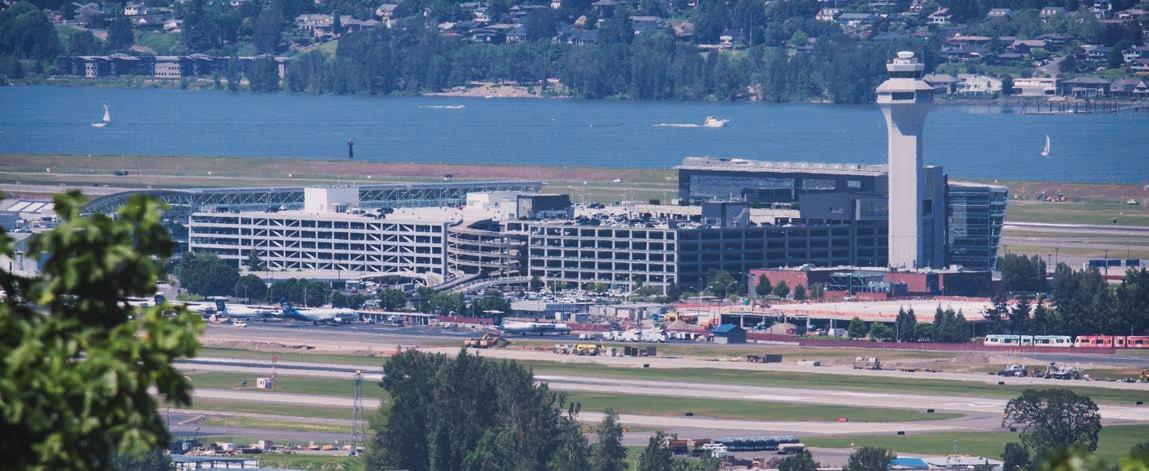
In some cases, pilots and dispatchers found the notams so confusing that they either neglected to file the proper alternate or had to scramble to find a legal alternate after flying a missed approach procedure at the destination. This resulted in some disruption and is one consequence of the C-band 5G cellular network deployment.
Many autoland (CAT II and III) approaches are not available for certain airplanes due to potential 5G issues. One pilot complained in an ASRS report: “Weather at PDX [Portland International Airport in Oregon] was at minimums for ILS CAT I, with autoland not available due to 5G tower location. Fix the 5G issues! This is adding a
lot of additional workload and safety hazards to flights that should be easy utilizing a proven safe autoland system.”
In the ASRS 5G results, pilots reported a variety of anomalies that may have been a result of 5G interference. These incidents can’t be considered definitively due to 5G interference, however; many of the reporters cited GPS interference, which could have been caused by intentional jamming tests by the U.S. military.
Yet some reports included worrisome instances of aircraft systems either shutting down or operating in a manner that required pilot intervention. This included an autopilot that nosed the airplane down close to the ground, autothrottle shutoffs, and head-up display (HUD) anomalies.
A pilot flying into Sarasota/Bradenton International Airport in Florida in visual meteorological conditions (VMC) had the ILS Runway 14 approach loaded in the avionics to provide a backup, always a good idea to confirm the aircraft is aligned with the correct runway. According to an ASRS report: “At approximately minimums (200 feet agl), HUD indications shimmered, then blinked, and then filled display with all kinds of data/warnings, to include what I believe was the attitude lines of the unusual attitude recovery mode, largely blocking all direct view through the HUD and making it impossible to use and difficult to look through.
“At approximately 150 feet agl (estimated by looking out window), GPWS flare callouts began to count down 50, 40, etc., like aircraft wanted me to flare. I was way too high for that. FO (first officer) pilot monitoring stated: ‘That’s not right’ and asked me what was going on. I said I lost HUD and was proceeding visually.
“I was able to ‘fly through the HUD,’ ignoring its information to a normal landing. He said he saw no other indications. I have no idea [of the cause]. HUD was inop
from 200 feet down. I talked to another captain, and he told me to treat it like a failure and put in AML [maintenance log], which we did. We both understood that 5G is not supposed to be on yet, so elected to treat as a failure. Maintenance could find no faults in subsequent checks and signed it off. Next leg was no problem. Delayed flight about an hour.”
After a departure from Portland International Airport, a flight crew notified the departure controller that the avionics made a radar altitude callout of 1,000 feet while the aircraft was climbing through 2,300 feet. At 11,600 feet, the callout said “ten” and the autothrottles disconnected. The pilots reported this to the Seattle Center controller, and all would have been fine from this point had the pilots not been distracted by the random callouts.
check” approach to Runway 25L at Los Angeles International Airport, a pilot reported a problem with the autopilot. “Approach was normal at first, received [autoland] ‘Land Green’ before 350 feet. On short final, I believe it was below 100 feet agl, near the overrun, the plane started an aggressive nose-over descent. I took control of the aircraft and raised the nose and landed.
“In hindsight with time to process the events, I should have gone around. At the time I was reacting to a sudden and unexpected event and did not have time to think. I did not see an autoland light before the nose over. [This] may be a 5G interference. It was a very alarming pushover by the autopilot. In IMC conditions, it could have caused a crash.”
One of the pilots reported to the ASRS, “I went heads down to report the occurrences to the company via ACARS and failed to recognize we climbed through FL180 and failed to complete the after-takeoff checklist, most importantly failed to reset the altimeters to 29.92. We leveled at FL370 for less than a minute with the altimeters set to the departure airport, and this put us at approximately FL367. We corrected the altimeters and completed level-off at FL370. I got distracted by abnormal radio altitude callouts and autothrottle disconnect due to 5G interference. I was pre-disposed to think the implementation would be a non-event and was surprised to experience actual interference events. I then rushed to comply with company reporting requirements, which should have waited until the next phase of flight.”
In VMC during an autoland “confidence
While nearing Phoenix, a flight crew noticed that the autobrakes disarmed two times after being set, so they finally selected manual braking. After the captain’s radar altimeter flagged red (inoperative), the pilot flying reported, “In the flare I noticed a resistance to pitching up. It almost felt like the autopilot was still engaged. I overcame the resistance to set the landing attitude. Additionally, the AT [autothrottles] did not go to idle at 27 feet as normal.
“I manually closed the thrust levers prior to touchdown. The spoilers worked normally. As the nosewheel came in contact with the runway, the thrust levers started to move forward. I held them back and disarmed the AT. This delayed my engaging the thrust reversers a few seconds. The aircraft was stopped without incident.”
The potential interference from 5G cellphone towers in the U.S. isn’t going away, and these reports suggest that this is still a significant safety issue. AIN will follow up this report with any additional information submitted on 5G interference and the response from the FAA to the request for reports to the Report a Radio Altimeter Anomaly website.
I was predisposed to think the implementation [of 5G] would be a non-event...
British aerospace engineer Jason Hill became enthralled with helicopters in his youth while watching the television show, Airwolf, the highly fictionalized account of a Bell 222 converted to a supersonic assault weapon. The experience led to a decadeslong dream of producing a stylish, modern light-helicopter design he unveiled in 2020, the five-seat Hill HX50.
By last November, Hill Helicopters had attracted hundreds of orders and produced its first carbon-fiber, single-piece fuselage. It plans to begin flight testing by the end of 2023.
The effort, largely funded by Hill’s successful engineering firm Dynamiq, has drawn its share of skeptics, but Hill plods on with near-monthly progress reports he broadcasts live on YouTube. The videos are a quirky combination of a slick infomercial, college engineering lecture, and town hall meeting, with Hill personally fielding live questions from the electronic audience. Other videos posted by the
company feature interviews with Hill’s wife, brother, and colleagues, all testifying to Hill’s long-standing and complete commitment to the helicopter. Isabella Hill calls her husband’s drive to build the HX50, “an obsession.”
The carbon-fiber HX50 is more Tesla than Airbus with a splash of Bell 525. The interior, Hill notes, is more spacious than his Range Rover, with a baggage hold easily capable of swallowing three full-sized rollaway bags or multiple sets of golf clubs. Exterior styling cues unmistakably harken back to the 222, amplified with the smooth curves and twists that only molded composite construction can offer. Performance targets include a 140-knot cruise speed, 700-nm maximum range, and 1,760 pounds of useful load.
A helicopter pilot himself, Hill regularly flies a Robinson R66, and his slavish devotion to creating and manufacturing a near-completely, vertically-integrated aircraft could have been taken straight out
of Frank Robinson’s playbook. Hill has actually gone Robinson one better—he plans on building his own 500-shp turboshaft engine.
“We make stuff in-house,” Hill said. “We have absolute, total control of our cost base. What that means for [customers] is not only we deliver you an aircraft at the right price point, it also means that we can control the cost of spares and that the through-life costs of support are properly controlled.” That price point is currently $708,000 for the base HX50 and slightly less than $1 million for the HC50, a price on par with the Robinson R66.
Options include in-seat electric heaters and air-conditioned seat ventilation; a refrigerated center console compartment beneath the armrest cushion to chill drinks and snacks; and a power supply for each passenger’s tablet computer with audio streamed directly to passenger headsets.
Other options include a pilot-operable folding blade system, a Helimove electric

For Medical Services operations, speed of response is critical. Thanks to the combination o advanced technolo ies and inherent fexibility, Leonardo’s product ran e uarantees a rapid and capable response. Spacious and readily reconf urable cabins, advanced avionics and all-weather capability, day and ni ht, ensure that medical personnel can always be there when it counts.
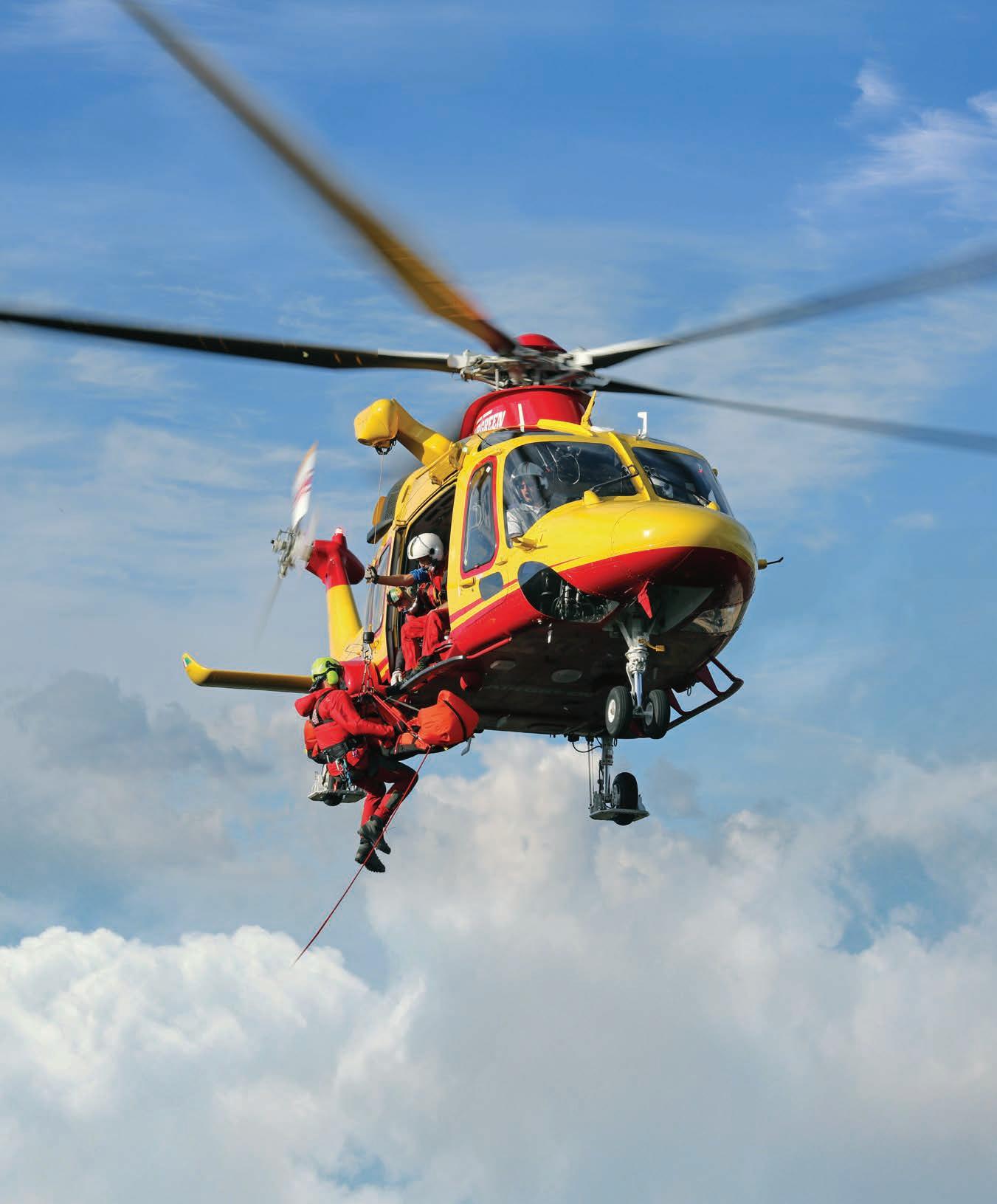
ground handling system, Home Base secure wireless link to power hangar doors, skids or wheeled gear, and an emergency float system. A two-axis autopilot is standard, a four-axis is optional.
So far the market has responded positively to the plucky Hill’s endeavor. By the end of 2021, Hill had received 342 orders for the kit-built HX50 and to-be-certified HC50. In December 2022, that number had more than doubled, closing in on 800 and backed by $36,000 deposits each.
Via the YouTube videos, Hill painstakingly documents progress on the HX50, mindful of the stigma often attached to start-ups and “vaporware.”
“We’ve pulled together a range of technologies from lots of different industries involved in composite production to bring the price point of composite manufacture down to something that we needed,” Hill said. “In order to do that we’ve had to reject the aerospace norms. We’ve vertically integrated not just the carbon-fiber manufacturing but the pattern making, the mold making, and then the part manufacture itself. And with that has come endto-end control of the quality, the schedule, and the cost—not just the cost of making the finished airframe but also the cost of developing it”.
The first fuselage was built with prototype tooling and will be used to hone human factors calculations. Prior to being stu ff ed, it weighs around 77 pounds. Hill expects to complete a second full-scale fuselage early this year.
Fuel bladders hold 175 U.S. gallons and are located behind the rear cabin bulkhead and ahead of another bulkhead for the capacious luggage compartment.
Hill said the company’s GT50 singlestage gas turbine has been progressing “quickly,” aided by the use of 3D printing and driven by a modular design that is “simpler, more efficient, lighter, and easier to manufacture” with “an extremely low
The HX50’s interior looks more like a luxurious automobile than a traditional helicopter.

parts count” and that is easy to maintain.
The engine uses air-blast atomized fuel injectors for better efficiency and fewer emissions. The company is in the final stages of completing the aerodynamic optimization and is developing bearings, turbine blisks, gears, transmissions, and fabricated metal components.
For the cockpit, the company has begun work on flight dynamics and control features including stability augmentation.
“Now we’ve got formal aerodynamic design established for the aircraft that allows us to develop the way that the twoaxis autopilot will deliver stability augmentation; the altitude, heading, speed, and navigation hold functions; and the haptic feedback to provide envelope protection,” Hill said. “The four-axis autopilot will give you simultaneous control of altitude, speed, heading, or nav, and it can hover-hold. It gives you essentially cruise control in every aspect of life and then much more extensive envelope protection. All of those things are actively now being developed.”
The avionics test bench has been upgraded to include actual flight controls. Glare testing on the display screens and aircraft windows also is underway as is human factors testing of the cyclic and collective
stick, buttons, and switch heads, not just for functionality, but to ensure they convey a tactile “premium feel,” Hill said.
Hill already is well into planning for production. “The large demand for the aircraft is putting significant pressure on us to make sure our production facility is ready and it’s capable of scaling up to deliver the number of helicopters in the timeframe that we need,” Hill said. “In parallel with all of the activities that are going on from an engineering perspective, we’ve been pushing through all of the planning applications that are required. They’ve all been submitted and are awaiting a decision from the local government [at Creswell, UK]. We’ve got detailed design underway for the manufacturing system.
“I’m under no illusions what we have in front of us,” Hill said, while effusing confidence in the mission. “We can build the aircraft that people want, we can make it look the way you want, we can make it perform the way you want, and we can deliver it at a price point that you can afford. These [new manufacturing] processes fundamentally allow us to make a step change in what you’ve been used to because we can deliver both the performance and safety at that price point.”
“Now it’s just work.”






































Clemens Aviation, which operates a Part 145 repair station and aircraft charter, management, and sales business at Wichita Col. James Jabara Airport (KAAO), has received permission to begin selling fuel, making it the second FBO on the field.
The Wichita City Council approved the reclassification, which owner Dwayne Clemens told AIN was the goal when the family-owned business opened its facility at KAAO two years ago. According to Clemens, his company has been pumping 100,000 gallons a month from its own fuel farm for the 30 aircraft it manages. Its fuel farm can store 40,000 gallons of jet-A and 15,000 gallons of avgas.
To serve transient customers, Clemens has acquired three refuelers—two 5,000-gallon jet-A trucks and a 1,000-gallon avgas tanker. The Phillips 66-branded facility fueled its first transient jet in December.
The facility is open 24/7 and has 75,000 sq ft of hangar space—enough to be able to accommodate ultra-longrange business jets. Clemens Aviaton plans to break ground this month on two more hangars totaling 36,000 sq ft. Its 4,500-sq-ft terminal includes a pilot lounge with shower facilities and snooze room, 10-seat conference room, kitchen, business center, and refreshment bar. The FBO also offers on-site car rental, crew cars, and shuttle service.
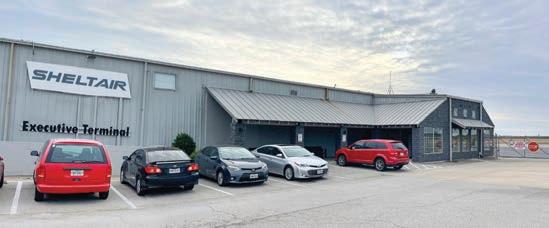
Canada-based aviation service provider Skyservice is continuing its expansion into the U.S. with the establishment of the second FBO at California’s Napa County Airport (KAPC).
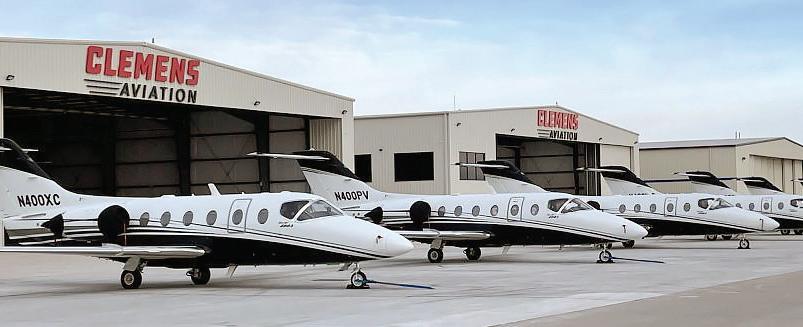
The company began operations there in November from a temporary modular facility but expects to break ground by mid-2023 on its permanent home.
The new Titan Fuels-branded complex will consist of a 20,000-sq-ft, two-story terminal featuring an upstairs restaurant with dining on an outdoor patio, a passenger lounge with refreshment bar, A/V-equipped conference
rooms on both levels, a pilot lounge, quiet rooms, and shower facilities. An adjoining 40,000-sq-ft hangar will be able to accommodate the latest ultra-long-range business jets.
The company also recently opened an FBO at Oregon’s Redmond Municipal Airport-Roberts Field (KRDM).
Universal Aviation’s Dominican Republic operation has been selected to manage, operate, and modernize the general aviation terminal (GAT) at Santo Domingo’s La Isabela/ Higuero Airport (MDJB). Of Santo Domingo’s two airports, MDJB, which has a 5,500-foot runway, is closer to the city, located just 25 minutes from the hotels and financial district.
The 1,700-sq-ft terminal features a VIP passenger room, conference room, and pilot lounge and offers direct ramp access, coordination of permits and maintenance, baggage handling, security, fuel, valet parking, and ground transfers.
According to Universal Aviation Dominican Republic, it can clear passengers and crew through the airport in about 15 minutes on average.
Sheltair has acquired U.S. Jet Center, one of two service providers at Texas’s Denton Enterprise Airport (KDTO). For the Florida-based FBO chain, this marks its 15th base, its first presence in Texas, and just its second west of the Mississippi.
The facility is open from 6 a.m. until 10 p.m. with after-hours callouts available. It includes a 5,700-sq-ft terminal with a passenger lounge and refreshment bar, concierge, conference room, pilot lounge, and snooze rooms, flight planning area, crew cars, and onsite car rental. It has more than 200,000 sq ft of hangar space including a dozen corporate hangars that can accommodate aircraft up to a Gulfstream G650.
The entire staff and management team of the facility will be retained including general manager Jay Robinson.
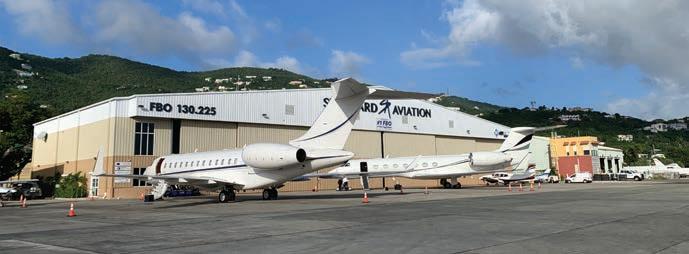
Standard Aviation, an FBO at St. Thomas’s Cyril E. King Airport (TIST), began in 2015, but once its permanent facility opened in October 2020 at the height of the Covid pandemic, things really took off. General manager Sabina Rosario recalled the surreal ribbon cutting, with the governor of the U.S. Virgin Islands in attendance, seats spread 20 feet apart, and everyone wearing a Standard Aviation face mask.
Since then, the facility has emerged as one of the pre-eminent FBOs in the region, logging more than 3,500 movements in 2022. The location’s peak season normally stretches from November through May, with many customers coming either to their second homes on-island or their home oisland in the form of a yacht.
“St. Thomas is very much a gateway,” Rosario told AIN during a recent visit to the location. “There are 12 other islands within a 50-mile radius here so we see a lot of tra c coming for the British Virgin Islands or other islands, where we have the longest runway. We have the most hangar space, so they come to us first and then they transfer.”
The facility consists of a 3,000-sq-ft, twostory terminal, including a passenger lobby with refreshment bar (the dispensers filled with chocolates have proven popular with flight crews), an upstairs pilot lounge with recliners, shower facilities, eight-seat A/Vequipped conference room with windows overlooking the ramp, customer storage space, laundry and dishwashing service, and a kitchen. Onsite car rental is available along with crew cars, and bottles of locallydistilled Botany Bay Rum are presented to favored customers.
The terminal adjoins a 24,000-sq-ft hangar, the largest private aircraft shelter in the Caribbean. A game-changer when it opened, it was built to withstand 160-mph winds and
is home to a based charter Pilatus PC-12 and Airbus Helicopters EC145. With its 240-foot door span, it can accommodate aircraft up to the latest ultra-long-range business jets.
A member of the Air Elite network, the World Fuel-branded location has 11 full-time and three part-time NATA Safety 1st-trained sta members. The FBO just saw the installation of its permanent fuel farm consisting of a pair of 20,000-gallon jet-A tanks and it expects to add a third in the near future. Before this, it relied on isotanks and a pumpskid to fill its fleet of one 7,000-gallon and two 5,000-gallon refuelers (all with inline Prist injection), which pumped approximately 1 million gallons of fuel in 2022.
Despite its posted operational hours of 7 a.m. to 7 p.m., the FBO is open past those hours most nights to accommodate medevac flights headed to the mainland’s superior medical care and other late-night traffic. While the island is considered U.S. territory, departing aircraft and passengers— even Americans—must still clear customs, which is normally open from 7 a.m. until 6 p.m. “We have the exclusive capability to request after-hours [clearance], under the reimbursable services program,” explained Rosario. “We can get customs at any hour for a fee, they’ve never really said no, and they aren’t overly expensive.”
As for catering, the company contracts with an o site private chef who can prepare gourmet meals but for other options it has relationships with local restaurants.
After 2017’s twin devastating hurricanes Irma and Maria churned their way through the islands, the FBO expanded its cargo-handling capacity, investing in forklifts and other equipment to handle large aircraft arrivals.
“There’s nothing we haven’t unloaded,” said Chris Curreri, the FBO’s director of operations, adding those cargoes have ranged from live dolphins to 10,000-pound spools of cable. “The Caribbean is a funny place, everybody and their brother seems to bring something interesting on their airplane. You open the cargo hold, and they say 'we’ve got a little generator in there,' [and it's] 700 pounds!”
In the past, St. Thomas had carried a reputation among operators as a pricey destination but Standard Aviation has worked to change that impression. “It was expensive to come here and I don’t think there was really any reason other than that was the price,” said Curreri, noting that TIST has gone from a place to be avoided on tech stops to a preferred one. “We give out rum for sure, and a lot of love, but I think we give out good value.” C.E.
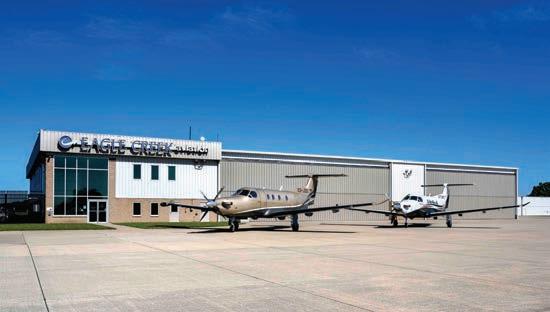
Pilatus and KCAC Aviation have approved Eagle Creek Aviation in Indianapolis as an authorized PC-12 service center. With the approval, Eagle Creek can perform maintenance on all variants of the Swiss OEM’s turboprop single, including the PC-12 NGX. KCAC, based at Johnson County Executive Airport in Olathe, Kansas, is an authorized dealer and service center for Pilatus in a nine-state region. Eagle Creek joins Premier Jet Center in Eden Prairie, Minnesota, as a PC-12 repair center in KCAC’s Midwest region. Founded 40 years ago, Eagle Creek is one of 12 operations under aviation management company Jet Access.
The first class of airframe and powerplant apprentices at Flexjet have graduated and received their A&P certificates after completing 30 months of paid, on-the-job training from the fractional jet provider. The 10 graduates also received full-time offers of employment from the Cleveland, Ohiobased company. A&P apprentices at Flexjet must pass an aptitude test and go through an in-depth interview process. Those candidates selected for the program earn $50,000 a year during training. Once complete, apprentices who are offered full-time employment receive base compensation of $80,000 and benefits. Other perks of the apprenticeship program include a Snap-On toolbox and a starter set of tools valued at nearly $30,000, which the technician can keep after three years of employment. Flexjet said it plans to hire at least 100 more A&Ps over the next 12 months.
Jet Aviation has bolstered its maintenance capabilities at its Dubai International Airport facility in response to customer
demand. The FBO and MRO arm of General Dynamics has added modular tail docking capability that will improve the efficiency of heavy structural repairs on large-cabin business jets, and refurbishment capability also has been expanded to include avionics modifications and upgrades. Increasing volumes of non-destructive testing and pre-purchase inspections have also prompted the facility to introduce improved techniques and equipment for eddy current and ultrasonic inspections, as well as expansion of its on-site boroscope capabilities. With the increased capabilities in Dubai, the company has extended its line maintenance to Al Bateen Airport in Abu Dhabi and on-demand services at Abu Dhabi International Airport. Next year, the company anticipates additional line maintenance expansion in Saudi Arabia. “The Middle East is a key strategic hub in our network and we are committed to supporting the growth of business aviation across the region,” said Jeremie Caillet, Jet Aviation’s senior v-p of EMEA regional operations.
Guernsey-based aviation services company ASG has added line and base maintenance of the Cirrus SF50 Vision Jet turbine single following EASA approval to add the type to its Part 145 certificate. The addition of the Williams FJ33-5A-powered SF50 to its repair station certificate follows the Pula Aviation Services company’s large investment in training, tools, and parts, and “further cements ASG’s position in Europe as the go-to Cirrus service center” for EASA-, 2-REG-, and FAA-registered SF50s, according to the company. ASG also holds approval for MRO services on the Cirrus SR-series piston singles.
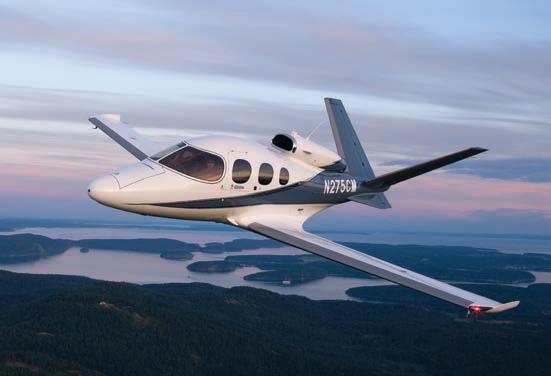

In its continuing e orts to bring more maintenance work in-house, Dassault Falcon Jet plans to begin construction in the second half of the year on a 175,000-sq-ft maintenance facility at Melbourne Orlando International Airport (KMLB) in Florida. An opening is expected in late 2024.
Dassault’s aim with the facility is to serve Falcon customers in North and South America. The facility will accommodate major maintenance and modifications on up to 18 Falcon aircraft simultaneously. “This new factory service center will considerably grow our presence in the U.S., positioning us to keep up with demand for state-of-theart maintenance services as the Falcon fleet grows and as new models such as the Falcon 10X and the extra widebody Falcon 6X enter service,” said Dassault Aviation chairman and CEO Eric Trappier.
As a heavy maintenance facility, the center will handle a range of inspections, repairs, and overhauls, such as line maintenance and C-checks, as well as engineering and modification services. Features will include workshops, customer offices and lounges, and a large warehouse to support work there. The service center will also include a 54,000-sq-ft paint shop, and Melbourne will serve as a regional distribution hub for parts.
Dassault selected Melbourne as the site for its maintenance facility because of the area’s skilled workforce, which includes about 35,000 people employed in aviation and aerospace. The region is also home to Embry-Riddle Aeronautical University and the Florida Institute of Technology. “We extensively evaluated several areas before we found that the business environment in Florida, along with its highly skilled workforce on the Space Coast, to be the perfect
Dassault Aviation’s 175,000-sq-ft Falcon service center at Melbourne Orlando International Airport will include a 54,000-sq-ft paint shop.
combination for this project,” Trappier said.
The Melbourne project marks Dassault’s latest move to bolster its service support in the U.S. The OEM added service capacity at its other U.S. sites, including its Little Rock, Arkansas completions center and service centers in St. Louis, Missouri; Stuart, Florida; and Reno, Nevada. Specifically, an additional maintenance bay was added in Reno, along with improved customer amenities and more e cient work areas.
Internationally, Dassault has bolstered its service network in the past couple of years through the roll-up of ExecuJet MRO Services, TAG Maintenance Services—now
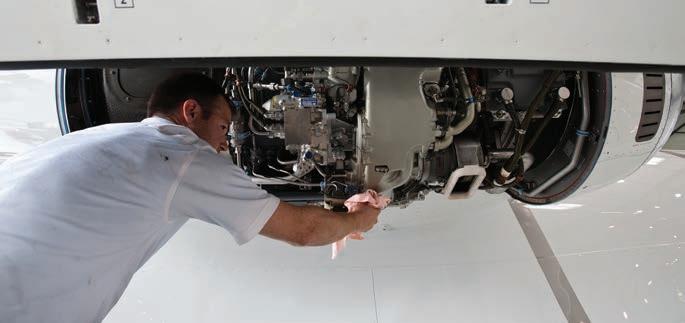
Dassault Aviation Business Services—and Ruag’s operations in Geneva and Lugano, Switzerland. That growth is continuing into this year with the opening of a 163,000-sq-ft ExecuJet MRO Services heavy maintenance facility in Dubai, UAE.
The company has also begun construction on a 149,500-sq-ft heavy maintenance center in Kuala Lumpur, Malaysia. When complete, that facility will accommodate between 18 and 24 Falcon jets, including Dassault’s newest twinjets, the 6X and 10X. In all, Dassault has 40 factory service centers and 20 authorized service centers around the world.
J.S.material on this page is based on reports by the o cial agencies of the countries having the reponsibility for aircraft accident and incident investigations. It is not intended to judge or evaluate the ability of any person, living or dead, and is presented here for informational purposes.
Piper PA-46-500TP, Nov. 9, 2022, Bignell, Nebraska
The 505-hour pilot and his sole passenger were killed when their single-engine turboprop slammed into the bank of an irrigation reservoir during an attempted ILS approach to Runway 30 of the North Platte Regional Airport. Prevailing weather included three-mile visibility under a 300foot overcast and an eight-knot crosswind from 030 degrees. Airmets were in effect for IFR conditions and low-level wind shear, but not icing. The Part 91 business flight originated in Lincoln, Nebraska, at 8:32 local time, climbing to a cruising altitude of 16,000 feet.
The pilot requested the ILS approach to Runway 30 after checking in with Denver Air Route Tra ffi c Control Center (ARTCC). The controller issued an initial vector of 230 degrees and cleared the flight to descend to 7,000 feet with a right turn to 280 degrees, followed by a descent to 5,000 feet and clearance for the approach with instructions to maintain 5,000 feet until established on the localizer. In the same clearance, without waiting for a readback, the controller told the pilot to change to the North Platte advisory frequency and report cancellation of his instrument flight plan. By the time a controller position change had been completed, radar contact had been lost and the relieving controller reported the flight overdue. At about that time, a resident three miles southeast of the airport called the local fire department to report smoke rising from a field. The debris field was just 50 feet in diameter.
ADS-B position data showed that during the last minute of the flight, its rate of descent increased from 500 feet per minute (fpm) to 3,000 fpm, reversed to a 2,000-fpm climb, and then abruptly entered a 5,000-fpm descent. The flight instructor who’d trained the pilot in the accident airplane said that he’d purchased it about three weeks earlier and received 10 hours of ground instruction and 15.1 hours in the cockpit. The pilot’s logbook, recovered from the wreckage, showed that he claimed 24.5 hours in the accident airplane with a career total of just 5.2 hours of actual instrument time, 1.0 of which came in high-altitude instruction during his transition training.
Fairchild SA227-AT, Nov. 15, 2022, Pewaukee, Wisconsin
A Part 135 charter transporting 53 crated rescue dogs came down on a golf course after the pilots responded to a discrepancy between the autopilot and flight director. Only minor injuries were reported to the two pilots and several dogs. Volunteers responded quickly, transporting people and dogs alike to shelter.
The flight from New Orleans was inbound on a coupled ILS approach to Runway 10 at Waukesha County Airport. The autopilot appeared to capture the localizer and glideslope, but the pilots noticed that the flight director indicated a climbing right turn. When they disconnected the autopilot to continue the approach manually, the airplane immediately rolled right. Both pilots got on the controls, succeeded in leveling the aircraft, and increased power, but it struck the ground in a nearly wings-level attitude.
Both wings were separated by collisions with trees before it came to rest.
Cessna 208B Grand Caravan EX, Nov. 18, 2022, Snohomish, Washington
The four members of a flight-test and data collection team were killed when the Caravan’s right wing detached during a series of planned maneuvers. The accident took place on the third day of baseline data collection in support of an initiative to expand a supplemental type certificate (STC) for a Cessna 208B drag-reduction system. The purpose of the accident flight was to complete the previous day’s test card recording the airplane’s stall behavior at an aft center of gravity, which had been suspended when one of the crew members began to feel ill.
The right-seat pilot from the previous day, who was not on board the accident flight, reviewed radar track data and surmised that the crew was likely performing the next-to-last scheduled maneuver, a 30-degree left bank at 96 knots indicated airspeed with landing flaps, prop full forward, and the engine producing 930 footpounds of torque.
The radar track showed that the flight departed Renton, Washington, at 9:25 Pacific time, climbed to 9,700 feet, and for about 45 minutes performed a series of maneuvers between 6,500 and 10,275 feet. At 10:17 it returned to 9,700 feet and began turning left. At 10:19, after a nearly 360-degree turn, the track made a sharp left 180-degree turn and began descending at an initial rate of 14,000 feet per minute, which decreased to 8,700 fpm at the last radar hit. Witnesses described seeing a plume of white smoke when the airplane broke up, and security camera footage recorded it spinning down in a nose-low attitude.
The debris field spanned 1,830 feet of a grass farm field. The right wing was found 580 feet from the main wreckage with its strut still attached; fragments of the right flap were scattered through the debris. The left wing was separated but adjacent to the fuselage with its flap retracted.
Bell 206B, Sept. 24, 2019, Campbell River, British Columbia, Canada
Though the immediate cause of the accident was an in-flight deformation of a main rotor blade following an apparent disruption of engine power, the Transportation Safety Board (TSB) investigation also identified significant discrepancies in the operator’s installation of a replacement engine, testing and approval of aftermarket main rotor blades, and Transport Canada’s medical certification procedures. The TSB also called out serious deficiencies in the operator’s safety culture. The 16,200-hour commercial pilot was killed when the helicopter descended vertically into a building less than four minutes after taking off on a planned 22-nm flight to deliver supplies to a client’s cabin.
The flight departed the operator’s base at 11:00 local time on an easterly heading, turning southeast and climbing to 615 feet after crossing the coastline. At 11:02:50 it began to descend at a rate of 400 fpm and 87 knots groundspeed, accelerating to 92 knots and turning right at an altitude of 417 feet. After climbing to 620 feet during the turn, it began descending at an initial rate of 1,950 fpm and 63 knots groundspeed. During the next nine seconds groundspeed dropped to 54 knots. The helicopter departed controlled flight at an altitude of 200 feet and the main rotor struck the tail boom, separating a section of the tail boom cover. Surveillance camera footage showed that the main rotor
blades were bent or deformed and not turning during its final descent, and metallurgic examination of engine debris was consistent with a flame-out prior to impact.
The 1981-model helicopter was imported to Canada from South America in 2017 and underwent extensive maintenance and refurbishment, including installation of a replacement Rolls-Royce M250-C20B engine that had previously been installed in a Hughes 369 and then a Bell 206B3. The replacement engine was fitted with a Bendix fuel-control system that included one three-cubic-inch and one six-cubic-inch accumulator but no double check valve. The engine installation manual called for two six-cubic-inch accumulators with a double check valve to “dampen fuel system instability due to torsional vibrations inherent in the two-bladed rotor system of the Bell 206 series of helicopters.”
Company records showed that on September 18, the same pilot had to compensate for a 20 percent reduction in main rotor rpm. Following inspection of the fuel system and an uneventful test flight, maintenance personnel contacted Textron, learned that the existing fuel system configuration was incorrect and ordered replacement parts.
They arrived the day of the accident but had not yet been installed, and the company’s chief pilot had advised his colleagues that the helicopter was unairworthy in the interim. However, the accident pilot, who was one of the operator’s corporate officers, nevertheless chose to dispatch it for the short flight. Neither the troubleshooting work nor the test flight were recorded in the aircraft’s journey log as required by regulation.
In January 2019, the original aluminum main and tail rotor blades were replaced by composite blades manufactured under a U.S. STC subsequently approved by Transport Canada. The investigation found damage to both blades with “characteristics of different failure mechanisms, namely fiber breakage, ply separation, delamination, and debonding.” Microscopic examination of
the debris concluded that one main rotor blade had sustained significant undetected fatigue damage prior to the accident. The fatigue testing performed during the certification process relied on the “no-growth” standard of showing that damage sustained in service will not propagate before the component is retired. However, the blade manufacturer’s threat assessment “contained little quantitative assessment and stress/load data recorded” to determine the extent of damage arising from flaws assumed to be either pre-existing, or incurred at random locations, according to the TSB. The observed damage to the accident main rotor blades included a V-shaped fracture suggesting in-flight overstress from alternating torsional loads.
Post-mortem examination of the pilot found more than 75 percent obstruction of all four major coronary arteries. The pilot, whose age was given only as “more than 70 years,” had not advised his Civil Aviation Medical Examiners of several factors relevant to his physical fitness to fly, including elevated blood glucose and cholesterol, his use of more than one anti-hypertensive medications, and elevated liver enzymes.
He was known to be a smoker and overweight, and ascribed persistently elevated blood-pressure readings to “white-coat syndrome,” the tendency for anxiety to increase blood pressure during a medical exam. The TSB concluded that his risk of an incapacitating medical event was more than 5 percent per year, but that there was no direct evidence that incapacitation contributed to the accident. z
Get the latest bizav news !
The latest news, data, and analysis on the future of civil aviation.

Feb. 13, 2023
This notice of proposed amendment (NPA) proposes to mandate the installation of a crash-resistant fuel system (CRFS) onto existing rotorcraft designs that are still in production and the retrofit of existing rotorcraft that are operated in EASA member states. The objective of the NPA is to mitigate the risks linked to a post-crash fire involving rotorcraft. Comments are due by Feb. 13, 2023.
March 8, 2023
The FAA proposes to amend certain Part 25 (transport category airplanes) airworthiness regulations to standardize the criteria for conducting safety assessments for systems, including flight controls and powerplants on newly-certified airplanes. With this action, the FAA seeks to reduce risk associated with accidents and incidents that have occurred in service, and reduce risk associated with new technology in flight control systems, such as fly-by-wire. The intended effect of this proposed action is to improve aviation safety by making system safety assessment requirements more comprehensive and consistent. Comments are due by March 8, 2023.
May 31, 2023 and Nov. 30, 2023
The European Commission has delayed the onset of new passenger reporting requirements that were previously scheduled to start on Sept. 30, 2022. EES (Entry/ Exit System), designed to replace the current system of manual stamping of passports with an electronic record, is now scheduled to start a transitional phase in May 2023. Manual stamping of passports will end in mid-August 2023, and the transitional phase will end in February 2024. ETIAS (European Travel Information and Authorization System) is an online
pre-travel, and pre-boarding requirement applying to visa-exempt third-country nationals planning to travel to European states. It is expected to be implemented in November 2023.
June 2, 2023
The National Fire Prevention Association (NFPA) is granting a 24-month extension to the compliance deadline of its standards that call for airport fueling vehicle loading racks to be equipped with automatic shutoff devices that are compatible with fueling trucks. This extension to June 2, 2023, applies only to airports that adopted the 2022 revision of NFPA 407. The original compliance date of June 2, 2021, still applies for airports operating under the 2017 revision. The National Air Transportation Association is working with the FAA as to how the extension will affect current enforcement policy at Part 139 certificated airports.
June 7, 2023
The ADS-B Out requirement in Europe is Dec. 7, 2020, for aircraft receiving their certificate of airworthiness (C of A) on or after December 7. Aircraft that obtained their C of A between June 6, 1995, and Dec. 7, 2020, must arrange for retrofits to meet the ADS-B Out mandate by June 7, 2023. Both deadlines apply only to aircraft with an mtow exceeding 5,700 kg (12,566 pounds) or having a maximum cruising
true airspeed capability greater than 250 knots. Aircraft with a C of A dated before June 6, 1995 are exempt from European ADS-B requirements.
June 12, 2023 and Sept. 9, 2024
By June 12, 2023, covered operators under Parts 91, 91K, and 135 must complete submissions of reports to the pilot records database (PRD) of all historical records concerning training, alcohol testing, qualification, proficiency, and disciplinary actions dating on or after Jan. 1, 2015. Final compliance date for reporting historical records before Jan. 1, 2015, is Sept. 9, 2024. Also beginning on Sept. 9, 2024, the Pilot Records Improvement Act ceases to be effective and will not be an available alternative to PRD for operators, entities, or trustees to which these regulations apply.
As part of an interim final rule overhauling aviation maintenance technician school regulations (Parts 65 and 147), the FAA is transitioning from using the mechanic practical test standards (PTS) as the testing standard for obtaining a mechanic certificate. As a part of this transition, the FAA developed the mechanic airman certification standards (ACS), which adds task-specific knowledge and risk management elements. The FAA will use the PTS as the testing standard until July 31, 2023. Starting Aug. 1, 2023, the
FAA will use the ACS to conduct mechanic certification tests.
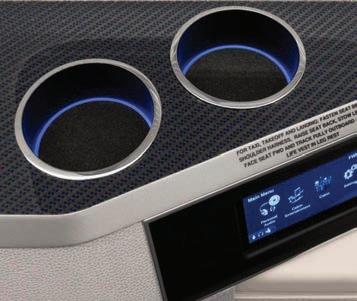

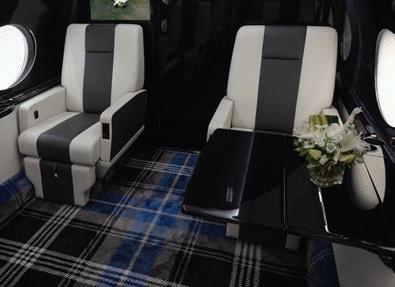
Aug. 10, 2023 and May 16, 2024 Canada: ADS-B

Due to continued supply chain impacts stemming from the Covid pandemic, the previously announced implementation dates for ADS-B Out in Canada is delayed beyond the original date of Feb. 23, 2023. As a result, the mandate will come into effect as follows: Class A Canadian airspace on Aug. 10, 2023; Class B Canadian airspace on May 16, 2024; and Class C, D, and E airspace to occur no sooner than 2026. The new dates have been developed from stakeholder feedback regarding supply chain limitations and backlogs to acquire and install the appropriate equipment.
Starting on Dec. 2, 2022 EASA Part 145 maintenance organizations were required to meet revised regulations. However, there is a two-year transition period, to Dec. 2, 2024, to allow maintenance organizations to correct any findings of non-compliance with the new Part 145 requirements. The main change introduced in the new regulations is the required implementation of a safety management system (SMS). The SMS process requires Part 145 maintenance organizations to implement hazard identification systems, risk management and safety assurance processes, and the designation of a safety manager. To support the safety management system process, several organization requirements have been changed including the safety policy, internal occurrence reporting, competence of staff, and compliance monitoring (replacing quality assurance).
For the most current compliance status, see: ainonline.com/cc

Columbia Helicopters named executive v-p Michael Tremlett president and CEO, succeeding Steve Bandy, who retired. Bandy continues to serve on the board of directors as vice chairman. Tremlett has more than 26 years of military and civilian aviation experience, with nearly 20 years as a strategic business development leader in aviation manufacturing, MRO, and depot sustainment organizations.
André Ebach was appointed CEO of Aero-Dienst after serving at the company for five years as an authorized signatory, head of maintenance, and executive board member. Before joining Aero-Dienst, Ebach held positions with Lufthansa Technik and Ruag Aviation.
Randy McKinney was named president by Elevate Aviation Group . McKinney has most recently served as COO for JSX and before that held the role of COO and executive v-p for DAL Global Services, a subsidiary of Delta Air Lines. He also has customer service and vendor management experience with NetJets.
Bristow Group appointed Elizabeth Matthews senior v-p, general counsel, head of government affairs, and corporate secretary. Matthews has more than 25 years of legal experience providing counsel across several different industries, most recently working in the energy sector for the past 21 years. Her legal career includes six years in private practice, 11 years at Chevron, and most recently as deputy managing director, executive v-p, and general counsel at TotalEnergies.

Jennifer Alessio was appointed to NBAA’s board of directors, where she will serve until the October 2023 annual meeting of members and then be eligible for election by the membership to a full, three-year term. Alessio is the director of aviation for the Hewlett Packard Enterprise (HPE) global aviation department. Before joining HPE in April 2015, she spent 16 years at McKesson, where she was the director of finance and analytics for the aviation and
corporate security department.
VoltAero appointed Martin Füllenbach as an independent director and Hervé Blanc as an advisory board member. Füllenbach is CEO and chairman of the board of SolydEra. His career includes serving as the CEO of Semperit, as CEO of Oerlikon Leybold Vacuum (now Atlas Copco Group), as CEO of Voith Marine Systems, as well as working at DaimlerChrysler Aerospace/EADS (now Airbus) in the defense systems division at Munich and Paris. Blanc is president of Beta Strategy, which provides coaching and guidance for projects in decarbonization, system architecture, and leadership. He formerly held the role of executive v-p and general manager of the Power Division at Safran Electrical and Power.

The Naples Airport Authority’s Noise Compatibility Committee (NCC) re-elected Chris Auron as chair and Richard Krawczun as vice-chair for 2023. Appointed to the NCC in March 2019, Auron is a pilot and aircraft mechanic who served in the U.S. Air Force for 10 years and later in the Arizona Army National Guard. Appointed to the NCC in March 2020, Krawczun has more than 35 years of experience in local and municipal government service.
Jet Support Services named Serdar Yorgancigil as chief information officer. Yorgancigil has more than 20 years of aviation and technology experience, previously holding senior roles at AAR Corp., including senior v-p of digital enablement.


TJ Spitzmiller returns to aircraft engineering and certification firm Peregrine as v-p of business development and administration. Spitzmiller has more than 20 years of experience in the aerospace industry, previously working in supply chain management at Eclipse Aviation and Honeywell, and as general manager of Sarasota Avionics.
Thomas Reese was hired by Unmanned Safety Institute as v-p of operations, succeeding Don Shinnamon who will transition to the
role of director of audit programs. Reese has a background in aeronautical science and operational experience in both crewed and remotely piloted aviation.

Luxaviation Group appointed Joachim Krüger as v-p of Northern Europe and managing director of the German entities, and Paul van der Blom as director for commercial development of the Northern European region. Krüger, a former German Air Force officer, has more than 20 years of experience in business aviation, previously working as a consultant for the Middle East, serving as an independent cargo/freight broker for VW, and co-founding FairJets, which was acquired by Luxaviaton in 2011. Van der Blom has 30 years of experience in commercial aviation in Europe, the Middle East, and Asia, holding aircraft management and sales positions with operators and aircraft manufacturers.
Andrew Fischer was hired by Priester Aviation as v-p of aircraft management. Fischer has nearly 30 years of experience in corporate aviation, having served for 19 years at NetJets in roles including program manager and v-p of sales; at Pentastar Aviation, where he worked as an aircraft management consultant; and most recently at Jet Linx.

Keystone Aviation named David Allen v-p of operations and Colleen McCauley v-p of sales and owner services. Allen joined Keystone in 2018 and most recently served as director of air carrier safety in Salt Lake City. Before that, he ran TAC Air’s Airline Services. McCauley has nearly 30 years of aircraft charter and management experience, previously as director of charter sales at an aircraft management company and president and director of flight operations at Jetworks International.
Maximilian Fahr was promoted by Deutsche Aircraft to serve as v-p of supply chain. Before his promotion, Fahr held the role of director of supply chain for two years. He previously held operational and strategic positions at Airbus in China and South Korea. He is also a Form 4 holder with Germany’s Luftfahrt Bundesamt airworthiness authority. z
Aviator and journalist Danna Kusianovich Henderson, 88, passed away at her home in Easton, Maryland on Nov. 20, 2022.
Henderson graduated from the University of New Mexico in 1955 with a degree in journalism and minor in archaeology. She then became a reporter for the Albuquerque Journal and learned to fly at the long-gone West Mesa Airport. In the early 1960s, she received her helicopter pilot certificate and joined the Whirly-Girls organization of women helicopter pilots.
Her career as an aviation journalist spanned approximately 50 years having also worked for publications including Aviation Daily as a reporter, managing editor of American Aviation , and as a freelance journalist for AIN . She also worked at Transpo ’72 for ALPA and AFA. The majority of her writing career was with Air Transport World , where she continued to contribute until she retired in 2011.
The French Air and Space Academy honored Eric Trappier, chairman and CEO of Dassault Aviation, with its Grand Prix 2022 award “for his remarkable career as an engineer and manager who has dedicated his career to the development of the French and European aeronautical industry.”
The National Aviation Hall of Fame (NAHF) announced its 2023 inductees, including pilot and astronaut Fred Haise, SpaceX founder Elon Musk, and former director general of Airports Council International Angela Gittens. Posthumously inducted into the 2023 NAHF class are aviation pioneers Velta Benn and Cornelius Co ey and business and general aviation legend Ed Stimpson. Inductees will be honored during a ceremony in Washington in fall 2023.
The 2023 class of Women in Aviation International (WAI) Pioneer Hall of Fame inductees will be recognized on February 25 during the WAI conference. Inductees include Nancy Bird, the first Australian woman to use her commercial license in Australia and founder of the Australian Women Pilots Association; Martha and John King, owners and founders of King Schools; and military trailblazer Col. Merryl Tengesdal USAF (Ret.).
The value, in this case, was that using one software platform—the Wyvern QSMS/ CASS module—the operator was able to provide useful information across its entire safety enterprise to include flight ops, maintenance, and quality assurance personnel to reduce risk, improve efficiencies, and potentially save money.
Wyvern’s Blume added, “Our aim is always to provide intuitive, useful functionality to maximize the safety professional’s time and effectiveness. By integrating SMS and CASS—utilizing common tools and techniques for both—we benefit from streamlined workflows as well as provide for the normalizing of data across features, which translates to efficiently and accurately arriving at actionable conclusions.”
A feature of the QSMS software is the risk management module (RMM) that allows an operator to determine root cause and practice “what if” planning scenarios to reduce operational risk. Blume said, “The RMM component at the heart of QSMS provides for a standardized workflow no matter where the risk is detected. The integrated Risk Visualization Tool allows the aviation professional to construct a graphical chain of events, facilitating determination of root cause and causal factors as well as capturing multiple threads of realized and potential consequence.”
In summary, Wyvern’s Bates said, “One way the CASS/SMS integration improves safety is by making the MEL process more transparent and ensuring close-looped communications between the functional areas (dispatch, aircraft maintenance, pilots). This integration keeps all these functional areas on the same sheet, negating the risk of dispatching an aircraft with an unknown anomaly.” He continued, “There are also cost and time savings elements to the integration since the SMS facilitates and enables all the CASS functions, which results in less training required, less software cost, and less time managing issues in different locations.” z
JAMES HOLAHAN (1921-2015), FOUNDING EDITOR, WILSON S. LEACH, FOUNDER & CEO
EDITOR-IN-CHIEF – Matt Thurber
NEWS EDITOR - AIN PUBLICATIONS – Chad Trautvetter
EDITOR AIN MONTHLY MAGAZINE – Kerry Lynch
SENIOR EDITORS – Charles Alcock – AIN/FutureFlight.aero, Curt Epstein, Gregory Polek – Air Transport, Int. Show Editions, Jerry Siebenmark, FutureFlight.aero writer/editor Hanneke Weitering
COPY/SOCIAL MEDIA EDITOR – Kait Wilson
David Donald – Defense, Mark Huber – Rotorcraft , Jennifer Leach English, David Jack Kenny – Safety Gordon Gilbert, Richard Pedicini, James Wynbrandt
PRODUCTION MANAGER – Martha Jercinovich GRAPHIC DESIGNERS –John A. Manfredo, Grzegorz Rzekos
DIRECTOR OF VIDEO – Ian Whelan
CHIEF OPERATING OFFICER – Dave Leach
VICE PRESIDENT SALES & MARKETING – Karl H. Elken
SENIOR DIRECTOR, INDUSTRY AFFAIRS AND EVENTS– Nancy O’Brien
ADVERTISING SALES
Michelle James – Midwestern U.S., Western U.S./Western Canada/Asia Pacific, +1 (520) 343-0236 Joe Rosone – Mid-Atlantic U.S./Southeast U.S./Caribbean/Brazil, +1 (301) 693-4687
Diana Scogna – Europe/Middle East, +33 6 62 52 25 47
Victoria Tod – Northeastern U.S./Eastern Canada/Great Lakes U.S./United Kingdom, +1 (203) 733-4184 Yury Laskin – Russia, +7 05 912 1346
AUDIENCE DEVELOPMENT DIRECTOR – Eileen Silberfeld MARKETING AND CLIENT SERVICES MANAGER – Lisa Valladares
SOCIAL MEDIA MARKETING – Zach O’Brien SALES ADMINISTRATOR – Cindy Nesline
DIRECTOR OF FINANCE & HUMAN RESOURCES – Michele Hubert ACCOUNTS PAYABLE – Mary Avella ACCOUNTS RECEIVABLE – Bobbie Bing
U.S. HEADQUARTERS
214 Franklin Ave., Midland Park, NJ 07432, +1 (201) 444-5075
Advertising Inquiries: +1 (201) 345-0085, adsales@ainonline.com Circulation Inquiries: +1 (201) 345-0085, subscriptions@ainonline.com
WASHINGTON, D.C. EDITORIAL OFFICE: Kerry Lynch (business aviation): klynch@ainonline.com, Tel: +1 (703) 969-9195
EUROPEAN EDITORIAL OFFICE: Charles Alcock: calcock@ainonline.com, Tel: +44 7799 907595
Wilson Leach, Dave Leach, Jennifer Leach English, Karl H. Elken, Matt Thurber, Michele Hubert, Nancy O’Brien
Aviation International News (ISSN 0887-9877) is published twelve times per year (monthly). Periodicals postage paid at Midland Park, N.J., and additional mailing o ces. Postmaster: Send address changes to Aviation International News, P.O. Box 8059, Lowell, MA 01853 USA. Allow at least eight weeks for processing. Include old address as well as new, and an address label from a recent issue if possible. Subscription inquiries: +1 (201) 345-0085 or email: subscriptions@ainonline.com.
Aviation International News is a publication of AIN Media Group, 214 Franklin Ave., Midland Park, NJ 07432; Tel.: +1 (201) 444-5075. Copyright © 2021 All rights reserved. Reproduction in whole or in part without permission of The Convention News Co., Inc. is strictly prohibited. The Convention News Co., Inc. publishes Aviation International News, AINalerts, AIN Air Transport Perspective, AINtv, Business Jet Traveler, BJTwaypoints, ABACE Convention News, Dubai Airshow News, EBACE Convention News, Farnborough Airshow News, FutureFlight.aero, HAI Convention News, LABACE Convention News, MEBA Convention News, NBAA Convention News, Paris Airshow News, Singapore Airshow News, Mobile Apps: Aviation International News; AINonline. PUBLICATION MAIL AGREEMENT NO. 40649046 RETURN UNDELIVERABLE CANADIAN ADDRESSES TO: PITNEY BOWES INTERNATIONAL MAIL, STATION A, P.O. BOX 54, WINDSOR, ON, N9A 6J5, returns il@imex.pb.com.
For feedback, letters to the editor, or other editorial needs, please contact AIN’s Editors at ainedit@ainonline.com


Bringing together a trusted group of corporate aviation leaders in a private, invitation-only setting.

Corporate Aviation Leaders: During this fully-hosted event, collaborate with peers, meet with OEM and aviation service providers, and hear from thought leaders during leadership sessions, peer breakouts, and curated networking to discuss the growing complexities of corporate aviation.

Flights, hotel, onsite meals, and registration are provided for all qualified attendees.
Sponsors: The Corporate Aviation Leadership Summit is a curated event that places you right in front of vetted decision-makers without the long nurturing process.
Sponsors will have guaranteed one-on-one meetings, plus board room style presentations to high level decisions makers. Additional sponsorship opportunities are available to raise your companies awareness. The number of sponsorships will be limited.
Submit an application to attend
Submit an application to sponsor






